Chapter 4: Data Analysis
VerifiedAdded on 2023/04/19
|25
|5362
|243
AI Summary
This chapter presents the data analysis conducted in the study on improving safety culture in the Malaysia Deepwater Production Contractor (MDPC) organization. The analysis includes qualitative and quantitative measures of various factors such as workforce sector, employee stats, work sector, and credibility. The findings reveal insights into the management and workforce's perception of safety culture in the organization.
Contribute Materials
Your contribution can guide someone’s learning journey. Share your
documents today.
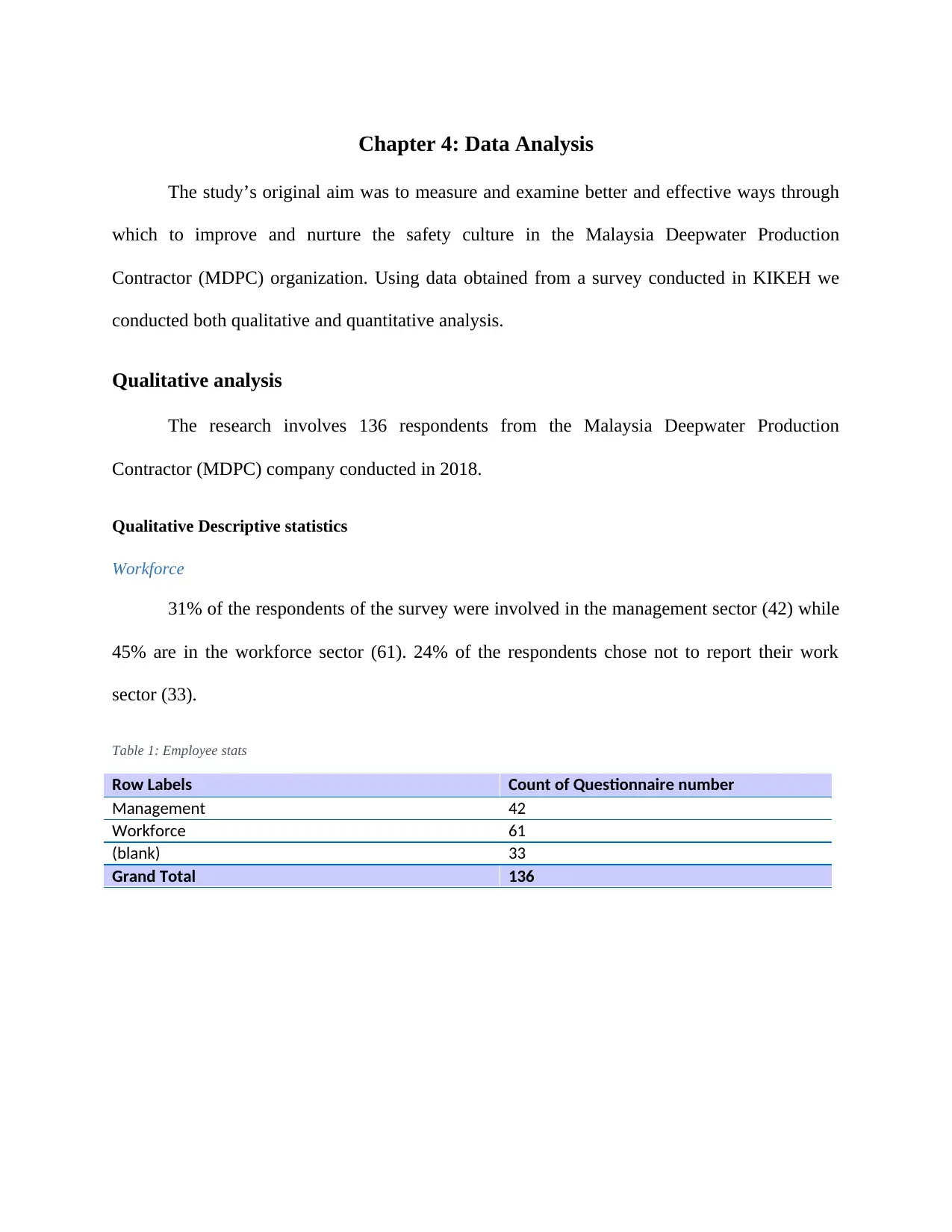
Chapter 4: Data Analysis
The study’s original aim was to measure and examine better and effective ways through
which to improve and nurture the safety culture in the Malaysia Deepwater Production
Contractor (MDPC) organization. Using data obtained from a survey conducted in KIKEH we
conducted both qualitative and quantitative analysis.
Qualitative analysis
The research involves 136 respondents from the Malaysia Deepwater Production
Contractor (MDPC) company conducted in 2018.
Qualitative Descriptive statistics
Workforce
31% of the respondents of the survey were involved in the management sector (42) while
45% are in the workforce sector (61). 24% of the respondents chose not to report their work
sector (33).
Table 1: Employee stats
Row Labels Count of Questionnaire number
Management 42
Workforce 61
(blank) 33
Grand Total 136
The study’s original aim was to measure and examine better and effective ways through
which to improve and nurture the safety culture in the Malaysia Deepwater Production
Contractor (MDPC) organization. Using data obtained from a survey conducted in KIKEH we
conducted both qualitative and quantitative analysis.
Qualitative analysis
The research involves 136 respondents from the Malaysia Deepwater Production
Contractor (MDPC) company conducted in 2018.
Qualitative Descriptive statistics
Workforce
31% of the respondents of the survey were involved in the management sector (42) while
45% are in the workforce sector (61). 24% of the respondents chose not to report their work
sector (33).
Table 1: Employee stats
Row Labels Count of Questionnaire number
Management 42
Workforce 61
(blank) 33
Grand Total 136
Secure Best Marks with AI Grader
Need help grading? Try our AI Grader for instant feedback on your assignments.
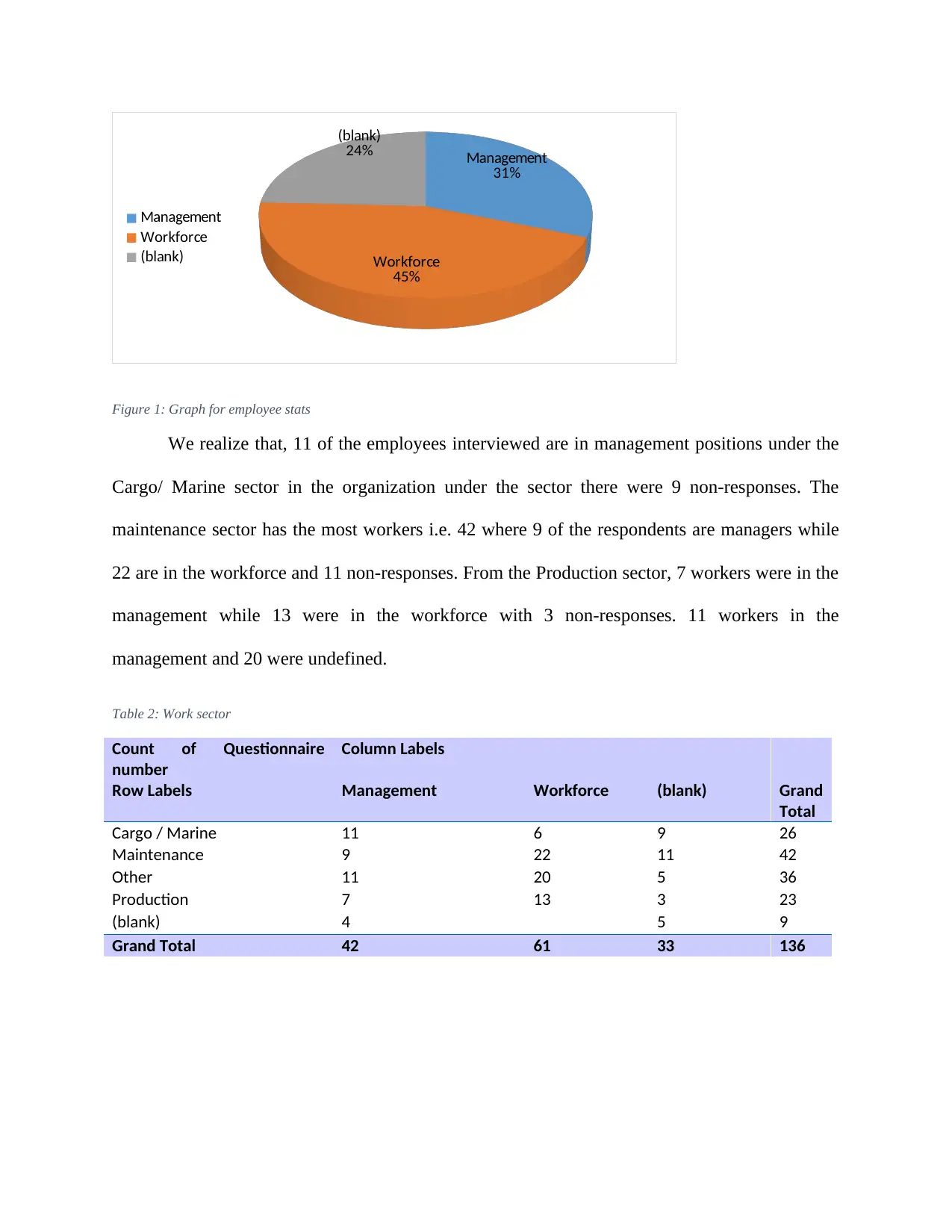
Management
31%
Workforce
45%
(blank)
24%
Management
Workforce
(blank)
Figure 1: Graph for employee stats
We realize that, 11 of the employees interviewed are in management positions under the
Cargo/ Marine sector in the organization under the sector there were 9 non-responses. The
maintenance sector has the most workers i.e. 42 where 9 of the respondents are managers while
22 are in the workforce and 11 non-responses. From the Production sector, 7 workers were in the
management while 13 were in the workforce with 3 non-responses. 11 workers in the
management and 20 were undefined.
Table 2: Work sector
Count of Questionnaire
number
Column Labels
Row Labels Management Workforce (blank) Grand
Total
Cargo / Marine 11 6 9 26
Maintenance 9 22 11 42
Other 11 20 5 36
Production 7 13 3 23
(blank) 4 5 9
Grand Total 42 61 33 136
31%
Workforce
45%
(blank)
24%
Management
Workforce
(blank)
Figure 1: Graph for employee stats
We realize that, 11 of the employees interviewed are in management positions under the
Cargo/ Marine sector in the organization under the sector there were 9 non-responses. The
maintenance sector has the most workers i.e. 42 where 9 of the respondents are managers while
22 are in the workforce and 11 non-responses. From the Production sector, 7 workers were in the
management while 13 were in the workforce with 3 non-responses. 11 workers in the
management and 20 were undefined.
Table 2: Work sector
Count of Questionnaire
number
Column Labels
Row Labels Management Workforce (blank) Grand
Total
Cargo / Marine 11 6 9 26
Maintenance 9 22 11 42
Other 11 20 5 36
Production 7 13 3 23
(blank) 4 5 9
Grand Total 42 61 33 136
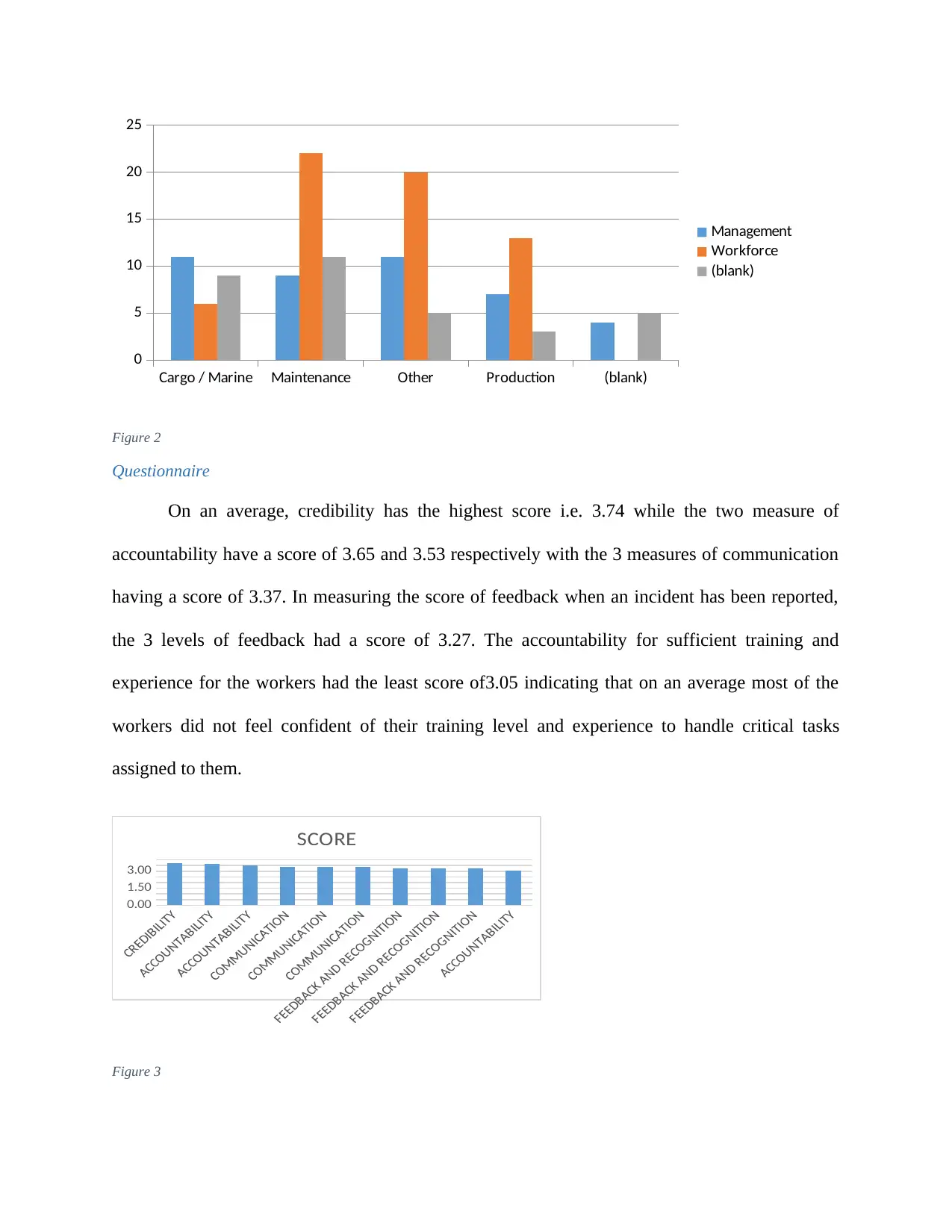
Cargo / Marine Maintenance Other Production (blank)
0
5
10
15
20
25
Management
Workforce
(blank)
Figure 2
Questionnaire
On an average, credibility has the highest score i.e. 3.74 while the two measure of
accountability have a score of 3.65 and 3.53 respectively with the 3 measures of communication
having a score of 3.37. In measuring the score of feedback when an incident has been reported,
the 3 levels of feedback had a score of 3.27. The accountability for sufficient training and
experience for the workers had the least score of3.05 indicating that on an average most of the
workers did not feel confident of their training level and experience to handle critical tasks
assigned to them.
0.00
1.50
3.00
SCORE
Figure 3
0
5
10
15
20
25
Management
Workforce
(blank)
Figure 2
Questionnaire
On an average, credibility has the highest score i.e. 3.74 while the two measure of
accountability have a score of 3.65 and 3.53 respectively with the 3 measures of communication
having a score of 3.37. In measuring the score of feedback when an incident has been reported,
the 3 levels of feedback had a score of 3.27. The accountability for sufficient training and
experience for the workers had the least score of3.05 indicating that on an average most of the
workers did not feel confident of their training level and experience to handle critical tasks
assigned to them.
0.00
1.50
3.00
SCORE
Figure 3
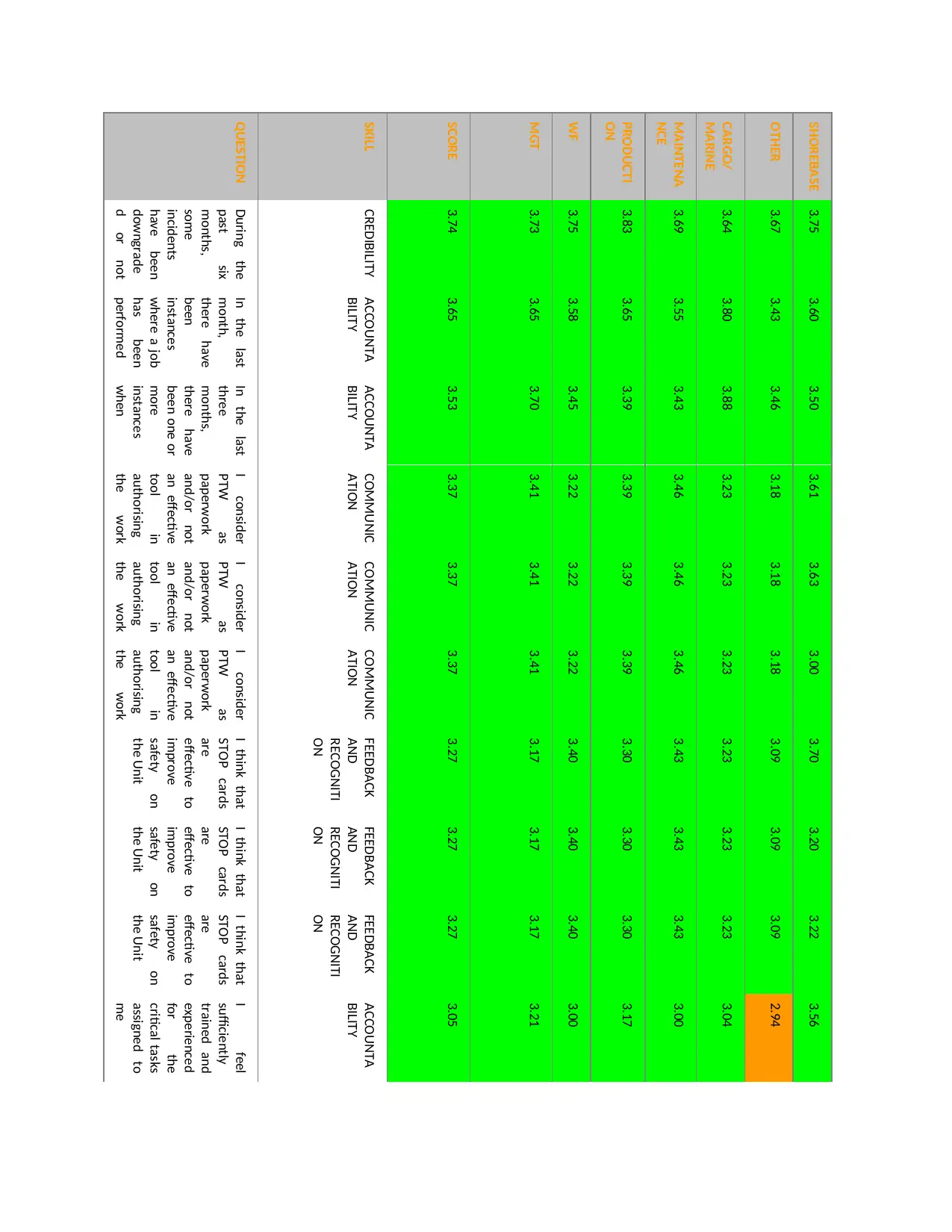
QUESTION
SKILL
SCORE
MGT
WF
PRODUCTI
ON
MAINTENA
NCE
CARGO/
MARINE
OTHER
SHOREBASE
During the
past six
months,
some
incidents
have been
downgrade
d or not
reported
CREDIBILITY
3.74
3.73
3.75
3.83
3.69
3.64
3.67
3.75
In the last
month,
there have
been
instances
where a job
has been
performed
by new
ACCOUNTA
BILITY
3.65
3.65
3.58
3.65
3.55
3.80
3.43
3.60
In the last
three
months,
there have
been one or
more
instances
when
someone
ACCOUNTA
BILITY
3.53
3.70
3.45
3.39
3.43
3.88
3.46
3.50
I consider
PTW as
paperwork
and/or not
an effective
tool in
authorising
the work
and
COMMUNIC
ATION
3.37
3.41
3.22
3.39
3.46
3.23
3.18
3.61
I consider
PTW as
paperwork
and/or not
an effective
tool in
authorising
the work
and
COMMUNIC
ATION
3.37
3.41
3.22
3.39
3.46
3.23
3.18
3.63
I consider
PTW as
paperwork
and/or not
an effective
tool in
authorising
the work
and
COMMUNIC
ATION
3.37
3.41
3.22
3.39
3.46
3.23
3.18
3.00
I think that
STOP cards
are
effective to
improve
safety on
the Unit
FEEDBACK
AND
RECOGNITI
ON
3.27
3.17
3.40
3.30
3.43
3.23
3.09
3.70
I think that
STOP cards
are
effective to
improve
safety on
the Unit
FEEDBACK
AND
RECOGNITI
ON
3.27
3.17
3.40
3.30
3.43
3.23
3.09
3.20
I think that
STOP cards
are
effective to
improve
safety on
the Unit
FEEDBACK
AND
RECOGNITI
ON
3.27
3.17
3.40
3.30
3.43
3.23
3.09
3.22
I feel
sufficiently
trained and
experienced
for the
critical tasks
assigned to
me
ACCOUNTA
BILITY
3.05
3.21
3.00
3.17
3.00
3.04
2.94
3.56
SKILL
SCORE
MGT
WF
PRODUCTI
ON
MAINTENA
NCE
CARGO/
MARINE
OTHER
SHOREBASE
During the
past six
months,
some
incidents
have been
downgrade
d or not
reported
CREDIBILITY
3.74
3.73
3.75
3.83
3.69
3.64
3.67
3.75
In the last
month,
there have
been
instances
where a job
has been
performed
by new
ACCOUNTA
BILITY
3.65
3.65
3.58
3.65
3.55
3.80
3.43
3.60
In the last
three
months,
there have
been one or
more
instances
when
someone
ACCOUNTA
BILITY
3.53
3.70
3.45
3.39
3.43
3.88
3.46
3.50
I consider
PTW as
paperwork
and/or not
an effective
tool in
authorising
the work
and
COMMUNIC
ATION
3.37
3.41
3.22
3.39
3.46
3.23
3.18
3.61
I consider
PTW as
paperwork
and/or not
an effective
tool in
authorising
the work
and
COMMUNIC
ATION
3.37
3.41
3.22
3.39
3.46
3.23
3.18
3.63
I consider
PTW as
paperwork
and/or not
an effective
tool in
authorising
the work
and
COMMUNIC
ATION
3.37
3.41
3.22
3.39
3.46
3.23
3.18
3.00
I think that
STOP cards
are
effective to
improve
safety on
the Unit
FEEDBACK
AND
RECOGNITI
ON
3.27
3.17
3.40
3.30
3.43
3.23
3.09
3.70
I think that
STOP cards
are
effective to
improve
safety on
the Unit
FEEDBACK
AND
RECOGNITI
ON
3.27
3.17
3.40
3.30
3.43
3.23
3.09
3.20
I think that
STOP cards
are
effective to
improve
safety on
the Unit
FEEDBACK
AND
RECOGNITI
ON
3.27
3.17
3.40
3.30
3.43
3.23
3.09
3.22
I feel
sufficiently
trained and
experienced
for the
critical tasks
assigned to
me
ACCOUNTA
BILITY
3.05
3.21
3.00
3.17
3.00
3.04
2.94
3.56
Secure Best Marks with AI Grader
Need help grading? Try our AI Grader for instant feedback on your assignments.

CREDIBILITY
ACCOUNTABILITY
ACCOUNTABILITY
COMMUNICATION
COMMUNICATION
COMMUNICATION
FEEDBACK AND RECOGNITION
FEEDBACK AND RECOGNITION
FEEDBACK AND RECOGNITION
ACCOUNTABILITY
2.80
3.00
3.20
3.40
3.60
3.80
MGT
CREDIBILITY
ACCOUNTABILITY
ACCOUNTABILITY
COMMUNICATION
COMMUNICATION
COMMUNICATION
FEEDBACK AND RECOGNITION
FEEDBACK AND RECOGNITION
FEEDBACK AND RECOGNITION
ACCOUNTABILITY
0.00
1.00
2.00
3.00
4.00
WF
Figure 4 Figure 5
COLLABORATION
ACTION ORIENTATION
COMMUNICATION
CREDIBILITY
ACCOUNTABILITY
FEEDBACK AND RECOGNITION
2.70
2.80
2.90
3.00
3.10
3.20
3.30
3.40
3.50
3.60
3.70
AVERAGE MGT
AVERAGE WF
Figure 6: Worker level
The credibility for the management has a score of 3.73 while that the workforce
has a higher credibility score of 3.75 Moreover, the accountability of the management is
higher than that of the workforce at 3.65 and 3.58, so is the communication skills of the
management which is higher than that of the workforce. However, the feedback and
ACCOUNTABILITY
ACCOUNTABILITY
COMMUNICATION
COMMUNICATION
COMMUNICATION
FEEDBACK AND RECOGNITION
FEEDBACK AND RECOGNITION
FEEDBACK AND RECOGNITION
ACCOUNTABILITY
2.80
3.00
3.20
3.40
3.60
3.80
MGT
CREDIBILITY
ACCOUNTABILITY
ACCOUNTABILITY
COMMUNICATION
COMMUNICATION
COMMUNICATION
FEEDBACK AND RECOGNITION
FEEDBACK AND RECOGNITION
FEEDBACK AND RECOGNITION
ACCOUNTABILITY
0.00
1.00
2.00
3.00
4.00
WF
Figure 4 Figure 5
COLLABORATION
ACTION ORIENTATION
COMMUNICATION
CREDIBILITY
ACCOUNTABILITY
FEEDBACK AND RECOGNITION
2.70
2.80
2.90
3.00
3.10
3.20
3.30
3.40
3.50
3.60
3.70
AVERAGE MGT
AVERAGE WF
Figure 6: Worker level
The credibility for the management has a score of 3.73 while that the workforce
has a higher credibility score of 3.75 Moreover, the accountability of the management is
higher than that of the workforce at 3.65 and 3.58, so is the communication skills of the
management which is higher than that of the workforce. However, the feedback and

recognition of the management is lower (3.17) while that of the workforce is higher
(3.40).
Sectors
CREDIBILITY
ACCOUNTABILITY
ACCOUNTABILITY
COMMUNICATION
COMMUNICATION
COMMUNICATION
FEEDBACK AND RECOGNITION
FEEDBACK AND RECOGNITION
FEEDBACK AND RECOGNITION
ACCOUNTABILITY
0.00
0.50
1.00
1.50
2.00
2.50
3.00
3.50
4.00
4.50
PRODUCTION
CREDIBILITY
ACCOUNTABILITY
ACCOUNTABILITY
COMMUNICATION
COMMUNICATION
COMMUNICATION
FEEDBACK AND RECOGNITION
FEEDBACK AND RECOGNITION
FEEDBACK AND RECOGNITION
ACCOUNTABILITY
0.00
0.50
1.00
1.50
2.00
2.50
3.00
3.50
4.00
MAINTENANCE
Figure 7 Figure 8
CREDIBILITY
ACCOUNTABILITY
ACCOUNTABILITY
COMMUNICATION
COMMUNICATION
COMMUNICATION
FEEDBACK AND RECOGNITION
FEEDBACK AND RECOGNITION
FEEDBACK AND RECOGNITION
ACCOUNTABILITY
0.00
1.00
2.00
3.00
4.00
CARGO/MARINE
CREDIBILITY
ACCOUNTABILITY
ACCOUNTABILITY
COMMUNICATION
COMMUNICATION
COMMUNICATION
FEEDBACK AND RECOGNITION
FEEDBACK AND RECOGNITION
FEEDBACK AND RECOGNITION
ACCOUNTABILITY
0.00
0.50
1.00
1.50
2.00
2.50
3.00
3.50
4.00
OTHER
Figure 9 Figure 10
(3.40).
Sectors
CREDIBILITY
ACCOUNTABILITY
ACCOUNTABILITY
COMMUNICATION
COMMUNICATION
COMMUNICATION
FEEDBACK AND RECOGNITION
FEEDBACK AND RECOGNITION
FEEDBACK AND RECOGNITION
ACCOUNTABILITY
0.00
0.50
1.00
1.50
2.00
2.50
3.00
3.50
4.00
4.50
PRODUCTION
CREDIBILITY
ACCOUNTABILITY
ACCOUNTABILITY
COMMUNICATION
COMMUNICATION
COMMUNICATION
FEEDBACK AND RECOGNITION
FEEDBACK AND RECOGNITION
FEEDBACK AND RECOGNITION
ACCOUNTABILITY
0.00
0.50
1.00
1.50
2.00
2.50
3.00
3.50
4.00
MAINTENANCE
Figure 7 Figure 8
CREDIBILITY
ACCOUNTABILITY
ACCOUNTABILITY
COMMUNICATION
COMMUNICATION
COMMUNICATION
FEEDBACK AND RECOGNITION
FEEDBACK AND RECOGNITION
FEEDBACK AND RECOGNITION
ACCOUNTABILITY
0.00
1.00
2.00
3.00
4.00
CARGO/MARINE
CREDIBILITY
ACCOUNTABILITY
ACCOUNTABILITY
COMMUNICATION
COMMUNICATION
COMMUNICATION
FEEDBACK AND RECOGNITION
FEEDBACK AND RECOGNITION
FEEDBACK AND RECOGNITION
ACCOUNTABILITY
0.00
0.50
1.00
1.50
2.00
2.50
3.00
3.50
4.00
OTHER
Figure 9 Figure 10
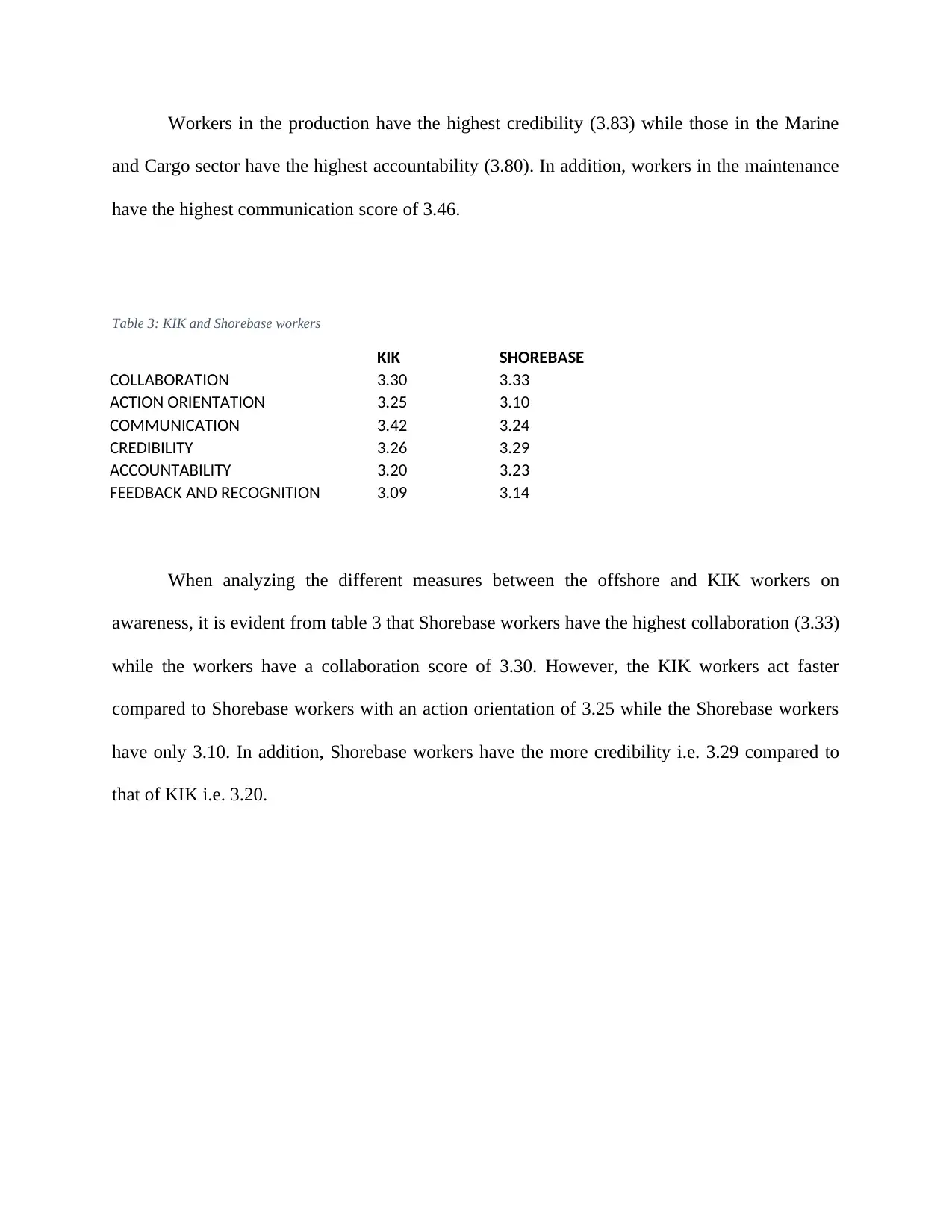
Workers in the production have the highest credibility (3.83) while those in the Marine
and Cargo sector have the highest accountability (3.80). In addition, workers in the maintenance
have the highest communication score of 3.46.
Table 3: KIK and Shorebase workers
KIK SHOREBASE
COLLABORATION 3.30 3.33
ACTION ORIENTATION 3.25 3.10
COMMUNICATION 3.42 3.24
CREDIBILITY 3.26 3.29
ACCOUNTABILITY 3.20 3.23
FEEDBACK AND RECOGNITION 3.09 3.14
When analyzing the different measures between the offshore and KIK workers on
awareness, it is evident from table 3 that Shorebase workers have the highest collaboration (3.33)
while the workers have a collaboration score of 3.30. However, the KIK workers act faster
compared to Shorebase workers with an action orientation of 3.25 while the Shorebase workers
have only 3.10. In addition, Shorebase workers have the more credibility i.e. 3.29 compared to
that of KIK i.e. 3.20.
and Cargo sector have the highest accountability (3.80). In addition, workers in the maintenance
have the highest communication score of 3.46.
Table 3: KIK and Shorebase workers
KIK SHOREBASE
COLLABORATION 3.30 3.33
ACTION ORIENTATION 3.25 3.10
COMMUNICATION 3.42 3.24
CREDIBILITY 3.26 3.29
ACCOUNTABILITY 3.20 3.23
FEEDBACK AND RECOGNITION 3.09 3.14
When analyzing the different measures between the offshore and KIK workers on
awareness, it is evident from table 3 that Shorebase workers have the highest collaboration (3.33)
while the workers have a collaboration score of 3.30. However, the KIK workers act faster
compared to Shorebase workers with an action orientation of 3.25 while the Shorebase workers
have only 3.10. In addition, Shorebase workers have the more credibility i.e. 3.29 compared to
that of KIK i.e. 3.20.
Paraphrase This Document
Need a fresh take? Get an instant paraphrase of this document with our AI Paraphraser

COLLABORATION
ACTION ORIENTATION
COMMUNICATION
CREDIBILITY
ACCOUNTABILITY
FEEDBACK AND RECOGNITION
2.90
3.10
3.30
3.50
KIK and Shorebase comparison
KIK SHOREBASE
Figure 11: Offshore (Shorebase) and KIK workers score
Moreover, the accountability of KIK is lower than that of Offshore workers i.e. 3.23 for
Shorebase workers and 3.20 for KIK workers. The KIK workers score for feedback and
recognition is 3.09 while that of Shorebase workers is higher at 3.14.
Quantitative analysis
Descriptive statistics
Table 4: Descriptive statistics
SCORE MGT WF PRODUCTION MAINTENANCE CARGO/MARINE OTHER SHOREBASE
Average 3.3921 3.4033 3.3648 3.4130 3.4343 3.3743 3.2282 3.4770
Median 3.3740 3.4146 3.4000 3.3913 3.4460 3.2308 3.1765 3.5800
Variance 0.0408 0.0507 0.0451 0.0358 0.0300 0.0827 0.0484 0.0620
Standard
deviation
0.2020 0.2252 0.2124 0.1892 0.1731 0.2875 0.2199 0.2490
Kurtosis 0.0793 -
1.5527
0.4147 1.7984 5.3881 -0.5546 0.2549 -0.3006
Maximum 3.7405 3.7250 3.7541 3.8261 3.6905 3.8800 3.6667 3.7500
Minimum 3.0522 3.1667 3.0000 3.1739 3.0000 3.0385 2.9429 3.0000
ACTION ORIENTATION
COMMUNICATION
CREDIBILITY
ACCOUNTABILITY
FEEDBACK AND RECOGNITION
2.90
3.10
3.30
3.50
KIK and Shorebase comparison
KIK SHOREBASE
Figure 11: Offshore (Shorebase) and KIK workers score
Moreover, the accountability of KIK is lower than that of Offshore workers i.e. 3.23 for
Shorebase workers and 3.20 for KIK workers. The KIK workers score for feedback and
recognition is 3.09 while that of Shorebase workers is higher at 3.14.
Quantitative analysis
Descriptive statistics
Table 4: Descriptive statistics
SCORE MGT WF PRODUCTION MAINTENANCE CARGO/MARINE OTHER SHOREBASE
Average 3.3921 3.4033 3.3648 3.4130 3.4343 3.3743 3.2282 3.4770
Median 3.3740 3.4146 3.4000 3.3913 3.4460 3.2308 3.1765 3.5800
Variance 0.0408 0.0507 0.0451 0.0358 0.0300 0.0827 0.0484 0.0620
Standard
deviation
0.2020 0.2252 0.2124 0.1892 0.1731 0.2875 0.2199 0.2490
Kurtosis 0.0793 -
1.5527
0.4147 1.7984 5.3881 -0.5546 0.2549 -0.3006
Maximum 3.7405 3.7250 3.7541 3.8261 3.6905 3.8800 3.6667 3.7500
Minimum 3.0522 3.1667 3.0000 3.1739 3.0000 3.0385 2.9429 3.0000
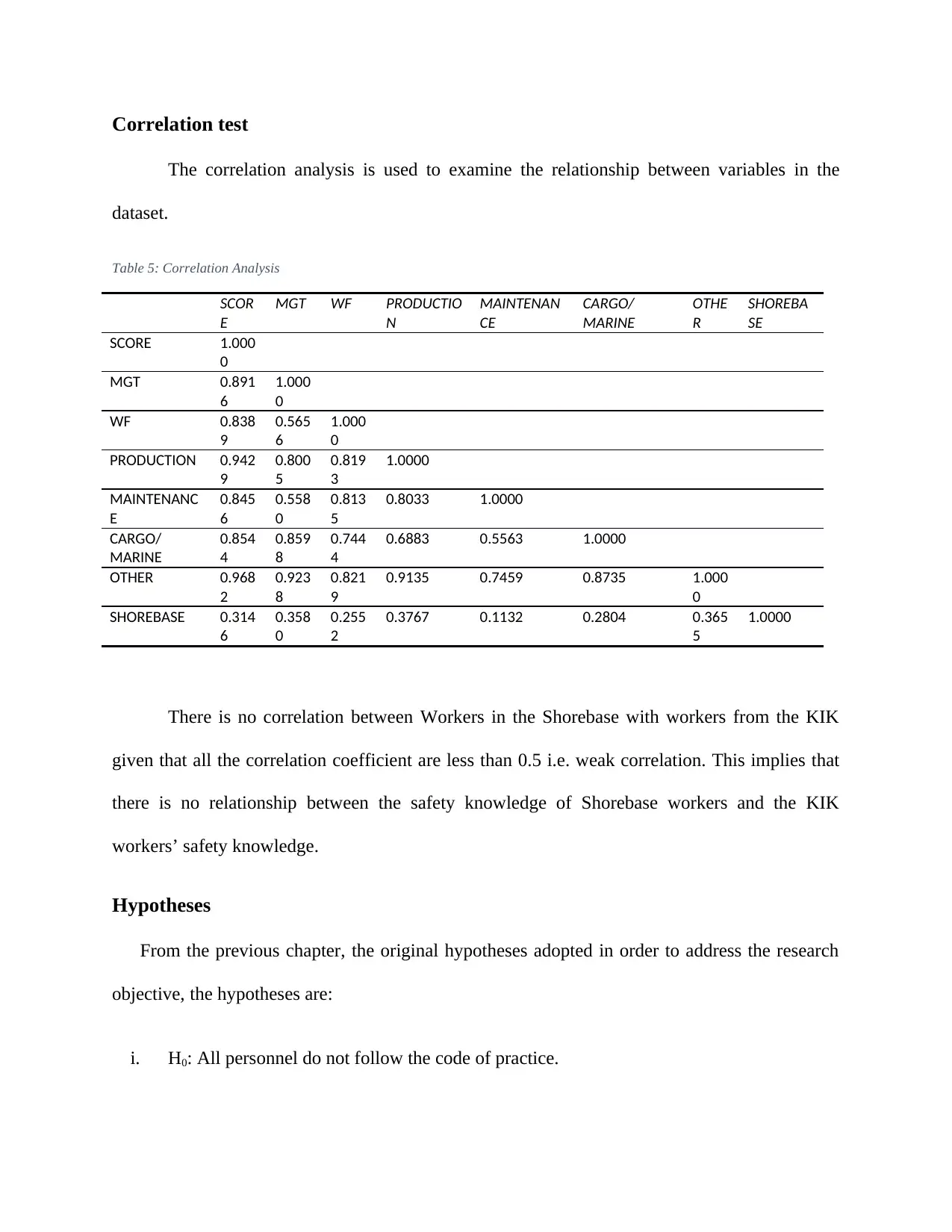
Correlation test
The correlation analysis is used to examine the relationship between variables in the
dataset.
Table 5: Correlation Analysis
SCOR
E
MGT WF PRODUCTIO
N
MAINTENAN
CE
CARGO/
MARINE
OTHE
R
SHOREBA
SE
SCORE 1.000
0
MGT 0.891
6
1.000
0
WF 0.838
9
0.565
6
1.000
0
PRODUCTION 0.942
9
0.800
5
0.819
3
1.0000
MAINTENANC
E
0.845
6
0.558
0
0.813
5
0.8033 1.0000
CARGO/
MARINE
0.854
4
0.859
8
0.744
4
0.6883 0.5563 1.0000
OTHER 0.968
2
0.923
8
0.821
9
0.9135 0.7459 0.8735 1.000
0
SHOREBASE 0.314
6
0.358
0
0.255
2
0.3767 0.1132 0.2804 0.365
5
1.0000
There is no correlation between Workers in the Shorebase with workers from the KIK
given that all the correlation coefficient are less than 0.5 i.e. weak correlation. This implies that
there is no relationship between the safety knowledge of Shorebase workers and the KIK
workers’ safety knowledge.
Hypotheses
From the previous chapter, the original hypotheses adopted in order to address the research
objective, the hypotheses are:
i. H0: All personnel do not follow the code of practice.
The correlation analysis is used to examine the relationship between variables in the
dataset.
Table 5: Correlation Analysis
SCOR
E
MGT WF PRODUCTIO
N
MAINTENAN
CE
CARGO/
MARINE
OTHE
R
SHOREBA
SE
SCORE 1.000
0
MGT 0.891
6
1.000
0
WF 0.838
9
0.565
6
1.000
0
PRODUCTION 0.942
9
0.800
5
0.819
3
1.0000
MAINTENANC
E
0.845
6
0.558
0
0.813
5
0.8033 1.0000
CARGO/
MARINE
0.854
4
0.859
8
0.744
4
0.6883 0.5563 1.0000
OTHER 0.968
2
0.923
8
0.821
9
0.9135 0.7459 0.8735 1.000
0
SHOREBASE 0.314
6
0.358
0
0.255
2
0.3767 0.1132 0.2804 0.365
5
1.0000
There is no correlation between Workers in the Shorebase with workers from the KIK
given that all the correlation coefficient are less than 0.5 i.e. weak correlation. This implies that
there is no relationship between the safety knowledge of Shorebase workers and the KIK
workers’ safety knowledge.
Hypotheses
From the previous chapter, the original hypotheses adopted in order to address the research
objective, the hypotheses are:
i. H0: All personnel do not follow the code of practice.
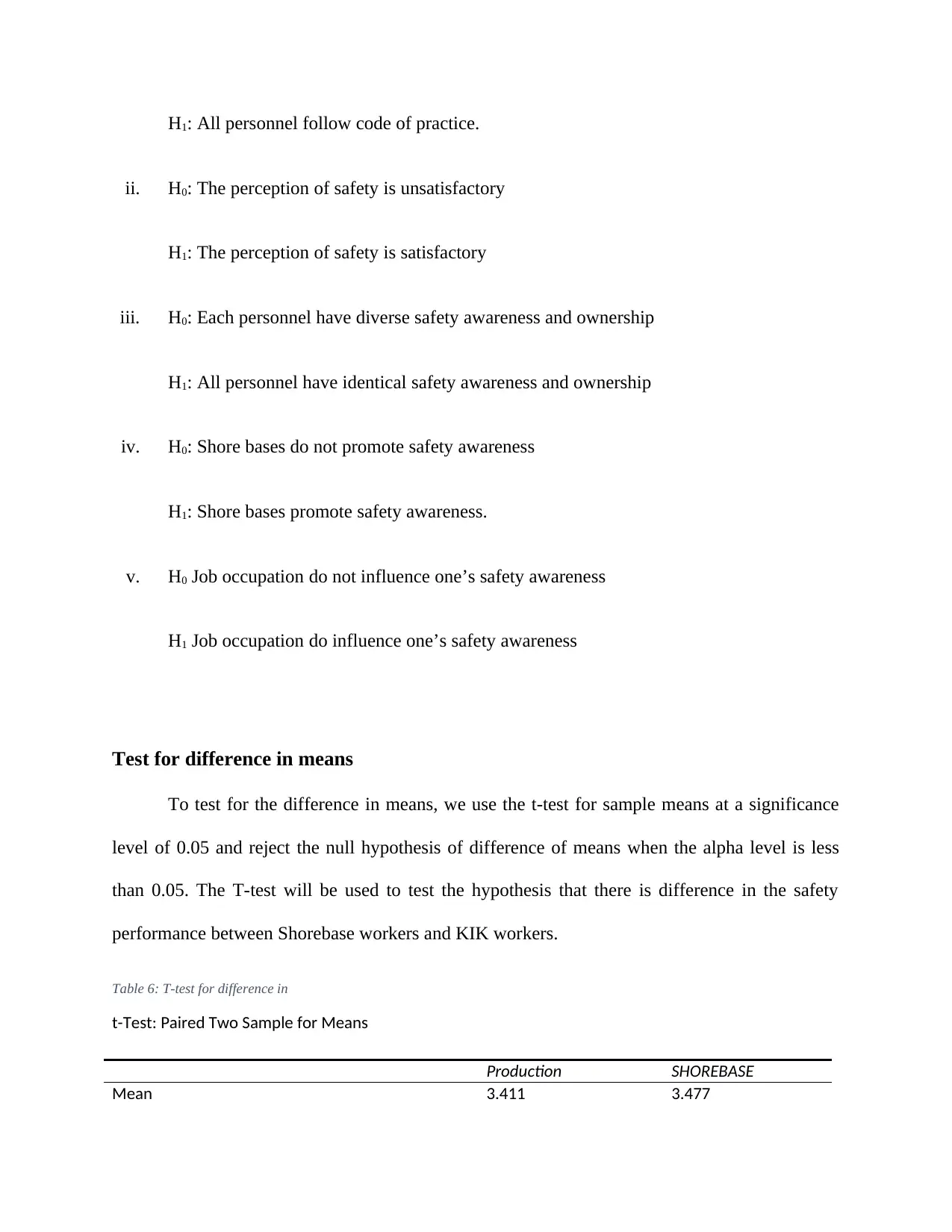
H1: All personnel follow code of practice.
ii. H0: The perception of safety is unsatisfactory
H1: The perception of safety is satisfactory
iii. H0: Each personnel have diverse safety awareness and ownership
H1: All personnel have identical safety awareness and ownership
iv. H0: Shore bases do not promote safety awareness
H1: Shore bases promote safety awareness.
v. H0 Job occupation do not influence one’s safety awareness
H1 Job occupation do influence one’s safety awareness
Test for difference in means
To test for the difference in means, we use the t-test for sample means at a significance
level of 0.05 and reject the null hypothesis of difference of means when the alpha level is less
than 0.05. The T-test will be used to test the hypothesis that there is difference in the safety
performance between Shorebase workers and KIK workers.
Table 6: T-test for difference in
t-Test: Paired Two Sample for Means
Production SHOREBASE
Mean 3.411 3.477
ii. H0: The perception of safety is unsatisfactory
H1: The perception of safety is satisfactory
iii. H0: Each personnel have diverse safety awareness and ownership
H1: All personnel have identical safety awareness and ownership
iv. H0: Shore bases do not promote safety awareness
H1: Shore bases promote safety awareness.
v. H0 Job occupation do not influence one’s safety awareness
H1 Job occupation do influence one’s safety awareness
Test for difference in means
To test for the difference in means, we use the t-test for sample means at a significance
level of 0.05 and reject the null hypothesis of difference of means when the alpha level is less
than 0.05. The T-test will be used to test the hypothesis that there is difference in the safety
performance between Shorebase workers and KIK workers.
Table 6: T-test for difference in
t-Test: Paired Two Sample for Means
Production SHOREBASE
Mean 3.411 3.477
Secure Best Marks with AI Grader
Need help grading? Try our AI Grader for instant feedback on your assignments.

Variance 0.03661 0.062023333
Observations 10 10
Pearson Correlation 0.377345442
Hypothesized Mean Difference 0
df 9
t Stat -0.833700839
P(T<=t) one-tail 0.213011012
t Critical one-tail 1.833112933
P(T<=t) two-tail 0.426022023
t Critical two-tail 2.262157163
At 9 degrees of freedom, the T-value for difference of means between Production and
Shorebase workers is -0.8337 with a p-value of 0.2130 hence fail to reject the null hypothesis
that there is a difference of means between Shorebase workers and Production workers.
t-Test: Paired Two Sample for Means
MAINTENANCE SHOREBASE
Mean 3.434 3.477
Variance 0.029937778 0.062023333
Observations 10 10
Pearson Correlation 0.114279916
Hypothesized Mean Difference 0
df 9
t Stat -0.47453096
P(T<=t) one-tail 0.323211896
t Critical one-tail 1.833112933
P(T<=t) two-tail 0.646423793
t Critical two-tail 2.262157163
At 9 degrees of freedom, the T-value for difference of means between Maintenance and
Shorebase workers is -0.47453 with a p-value of 0.3232 hence fail to reject the null hypothesis
that there is a difference of means between Shorebase workers and Maintenance workers.
Observations 10 10
Pearson Correlation 0.377345442
Hypothesized Mean Difference 0
df 9
t Stat -0.833700839
P(T<=t) one-tail 0.213011012
t Critical one-tail 1.833112933
P(T<=t) two-tail 0.426022023
t Critical two-tail 2.262157163
At 9 degrees of freedom, the T-value for difference of means between Production and
Shorebase workers is -0.8337 with a p-value of 0.2130 hence fail to reject the null hypothesis
that there is a difference of means between Shorebase workers and Production workers.
t-Test: Paired Two Sample for Means
MAINTENANCE SHOREBASE
Mean 3.434 3.477
Variance 0.029937778 0.062023333
Observations 10 10
Pearson Correlation 0.114279916
Hypothesized Mean Difference 0
df 9
t Stat -0.47453096
P(T<=t) one-tail 0.323211896
t Critical one-tail 1.833112933
P(T<=t) two-tail 0.646423793
t Critical two-tail 2.262157163
At 9 degrees of freedom, the T-value for difference of means between Maintenance and
Shorebase workers is -0.47453 with a p-value of 0.3232 hence fail to reject the null hypothesis
that there is a difference of means between Shorebase workers and Maintenance workers.
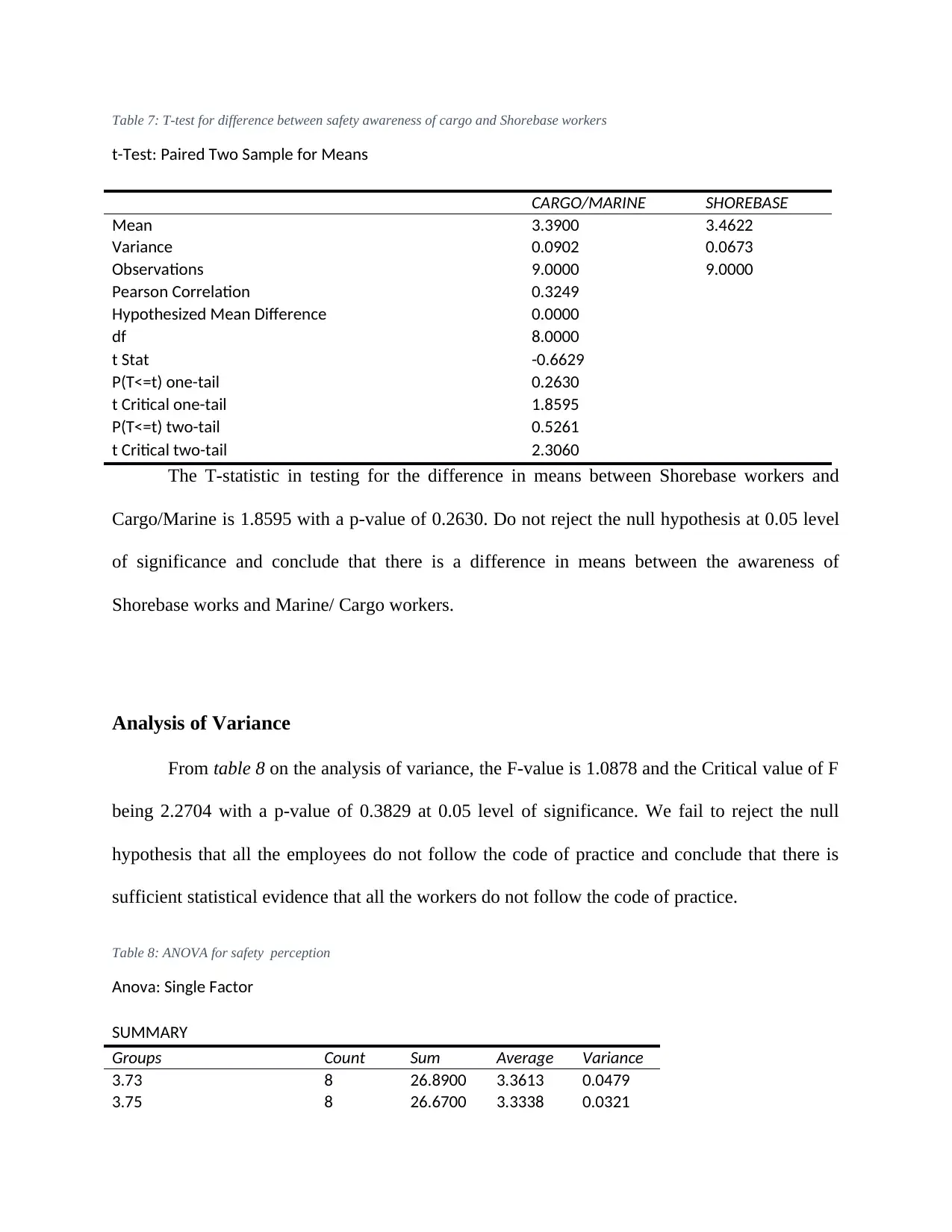
Table 7: T-test for difference between safety awareness of cargo and Shorebase workers
t-Test: Paired Two Sample for Means
CARGO/MARINE SHOREBASE
Mean 3.3900 3.4622
Variance 0.0902 0.0673
Observations 9.0000 9.0000
Pearson Correlation 0.3249
Hypothesized Mean Difference 0.0000
df 8.0000
t Stat -0.6629
P(T<=t) one-tail 0.2630
t Critical one-tail 1.8595
P(T<=t) two-tail 0.5261
t Critical two-tail 2.3060
The T-statistic in testing for the difference in means between Shorebase workers and
Cargo/Marine is 1.8595 with a p-value of 0.2630. Do not reject the null hypothesis at 0.05 level
of significance and conclude that there is a difference in means between the awareness of
Shorebase works and Marine/ Cargo workers.
Analysis of Variance
From table 8 on the analysis of variance, the F-value is 1.0878 and the Critical value of F
being 2.2704 with a p-value of 0.3829 at 0.05 level of significance. We fail to reject the null
hypothesis that all the employees do not follow the code of practice and conclude that there is
sufficient statistical evidence that all the workers do not follow the code of practice.
Table 8: ANOVA for safety perception
Anova: Single Factor
SUMMARY
Groups Count Sum Average Variance
3.73 8 26.8900 3.3613 0.0479
3.75 8 26.6700 3.3338 0.0321
t-Test: Paired Two Sample for Means
CARGO/MARINE SHOREBASE
Mean 3.3900 3.4622
Variance 0.0902 0.0673
Observations 9.0000 9.0000
Pearson Correlation 0.3249
Hypothesized Mean Difference 0.0000
df 8.0000
t Stat -0.6629
P(T<=t) one-tail 0.2630
t Critical one-tail 1.8595
P(T<=t) two-tail 0.5261
t Critical two-tail 2.3060
The T-statistic in testing for the difference in means between Shorebase workers and
Cargo/Marine is 1.8595 with a p-value of 0.2630. Do not reject the null hypothesis at 0.05 level
of significance and conclude that there is a difference in means between the awareness of
Shorebase works and Marine/ Cargo workers.
Analysis of Variance
From table 8 on the analysis of variance, the F-value is 1.0878 and the Critical value of F
being 2.2704 with a p-value of 0.3829 at 0.05 level of significance. We fail to reject the null
hypothesis that all the employees do not follow the code of practice and conclude that there is
sufficient statistical evidence that all the workers do not follow the code of practice.
Table 8: ANOVA for safety perception
Anova: Single Factor
SUMMARY
Groups Count Sum Average Variance
3.73 8 26.8900 3.3613 0.0479
3.75 8 26.6700 3.3338 0.0321
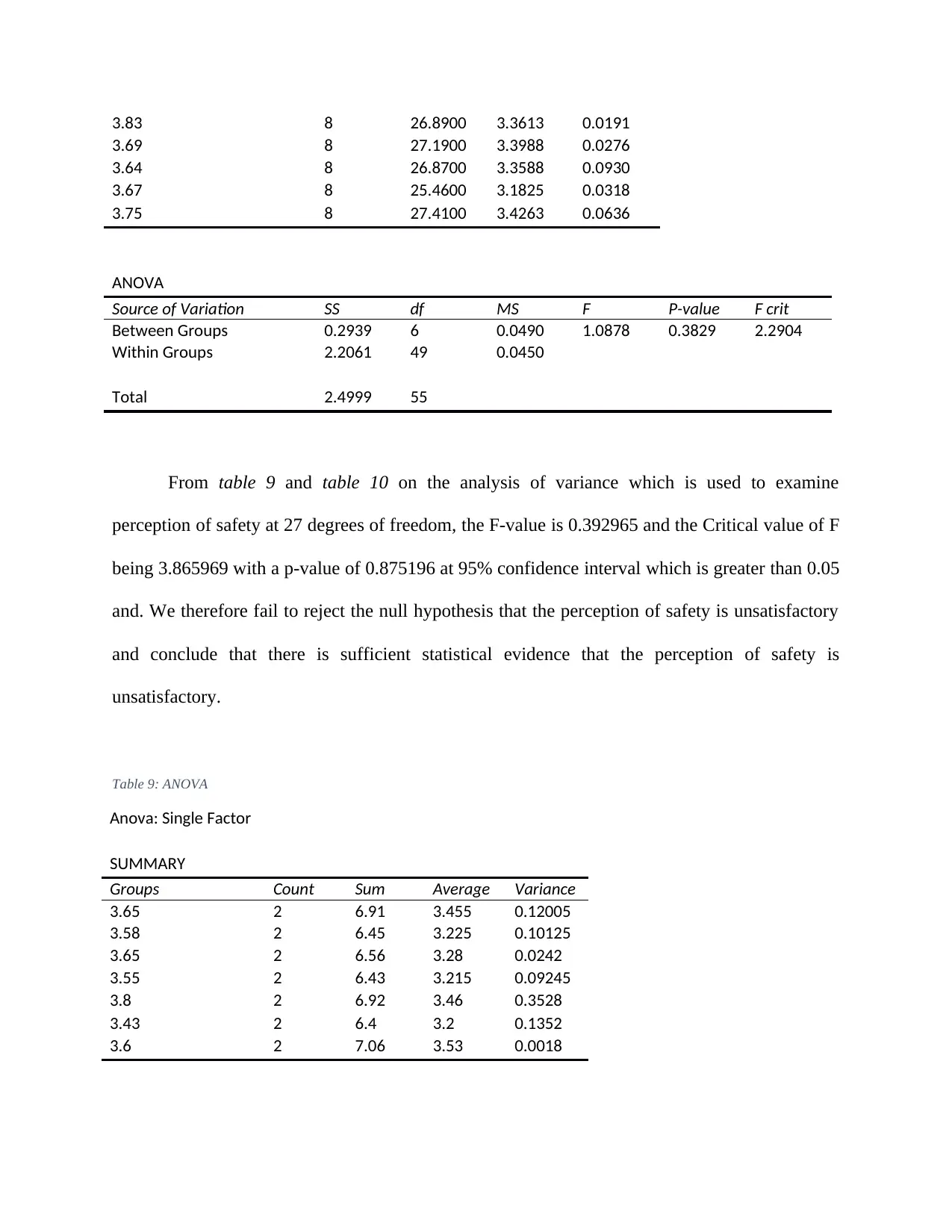
3.83 8 26.8900 3.3613 0.0191
3.69 8 27.1900 3.3988 0.0276
3.64 8 26.8700 3.3588 0.0930
3.67 8 25.4600 3.1825 0.0318
3.75 8 27.4100 3.4263 0.0636
ANOVA
Source of Variation SS df MS F P-value F crit
Between Groups 0.2939 6 0.0490 1.0878 0.3829 2.2904
Within Groups 2.2061 49 0.0450
Total 2.4999 55
From table 9 and table 10 on the analysis of variance which is used to examine
perception of safety at 27 degrees of freedom, the F-value is 0.392965 and the Critical value of F
being 3.865969 with a p-value of 0.875196 at 95% confidence interval which is greater than 0.05
and. We therefore fail to reject the null hypothesis that the perception of safety is unsatisfactory
and conclude that there is sufficient statistical evidence that the perception of safety is
unsatisfactory.
Table 9: ANOVA
Anova: Single Factor
SUMMARY
Groups Count Sum Average Variance
3.65 2 6.91 3.455 0.12005
3.58 2 6.45 3.225 0.10125
3.65 2 6.56 3.28 0.0242
3.55 2 6.43 3.215 0.09245
3.8 2 6.92 3.46 0.3528
3.43 2 6.4 3.2 0.1352
3.6 2 7.06 3.53 0.0018
3.69 8 27.1900 3.3988 0.0276
3.64 8 26.8700 3.3588 0.0930
3.67 8 25.4600 3.1825 0.0318
3.75 8 27.4100 3.4263 0.0636
ANOVA
Source of Variation SS df MS F P-value F crit
Between Groups 0.2939 6 0.0490 1.0878 0.3829 2.2904
Within Groups 2.2061 49 0.0450
Total 2.4999 55
From table 9 and table 10 on the analysis of variance which is used to examine
perception of safety at 27 degrees of freedom, the F-value is 0.392965 and the Critical value of F
being 3.865969 with a p-value of 0.875196 at 95% confidence interval which is greater than 0.05
and. We therefore fail to reject the null hypothesis that the perception of safety is unsatisfactory
and conclude that there is sufficient statistical evidence that the perception of safety is
unsatisfactory.
Table 9: ANOVA
Anova: Single Factor
SUMMARY
Groups Count Sum Average Variance
3.65 2 6.91 3.455 0.12005
3.58 2 6.45 3.225 0.10125
3.65 2 6.56 3.28 0.0242
3.55 2 6.43 3.215 0.09245
3.8 2 6.92 3.46 0.3528
3.43 2 6.4 3.2 0.1352
3.6 2 7.06 3.53 0.0018
Paraphrase This Document
Need a fresh take? Get an instant paraphrase of this document with our AI Paraphraser
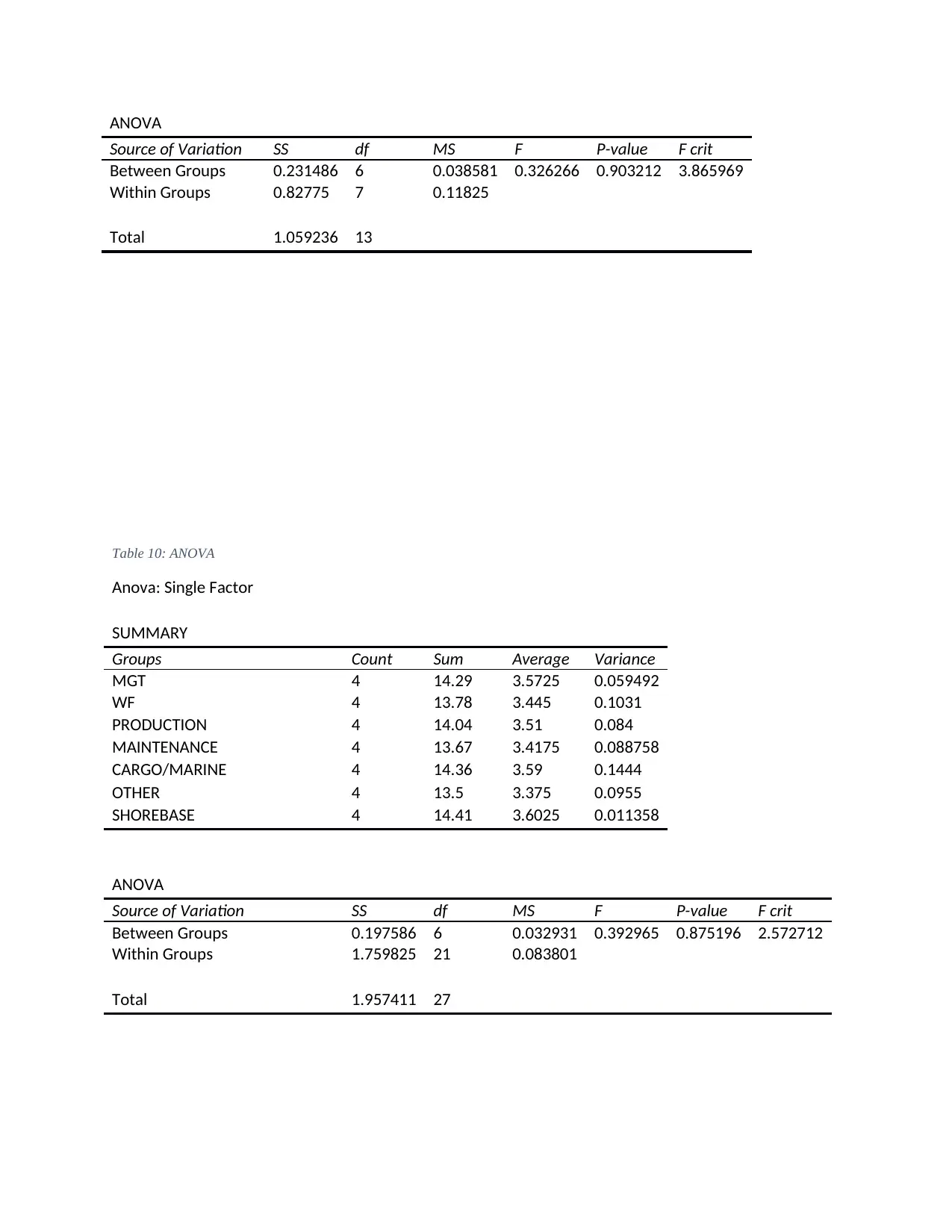
ANOVA
Source of Variation SS df MS F P-value F crit
Between Groups 0.231486 6 0.038581 0.326266 0.903212 3.865969
Within Groups 0.82775 7 0.11825
Total 1.059236 13
Table 10: ANOVA
Anova: Single Factor
SUMMARY
Groups Count Sum Average Variance
MGT 4 14.29 3.5725 0.059492
WF 4 13.78 3.445 0.1031
PRODUCTION 4 14.04 3.51 0.084
MAINTENANCE 4 13.67 3.4175 0.088758
CARGO/MARINE 4 14.36 3.59 0.1444
OTHER 4 13.5 3.375 0.0955
SHOREBASE 4 14.41 3.6025 0.011358
ANOVA
Source of Variation SS df MS F P-value F crit
Between Groups 0.197586 6 0.032931 0.392965 0.875196 2.572712
Within Groups 1.759825 21 0.083801
Total 1.957411 27
Source of Variation SS df MS F P-value F crit
Between Groups 0.231486 6 0.038581 0.326266 0.903212 3.865969
Within Groups 0.82775 7 0.11825
Total 1.059236 13
Table 10: ANOVA
Anova: Single Factor
SUMMARY
Groups Count Sum Average Variance
MGT 4 14.29 3.5725 0.059492
WF 4 13.78 3.445 0.1031
PRODUCTION 4 14.04 3.51 0.084
MAINTENANCE 4 13.67 3.4175 0.088758
CARGO/MARINE 4 14.36 3.59 0.1444
OTHER 4 13.5 3.375 0.0955
SHOREBASE 4 14.41 3.6025 0.011358
ANOVA
Source of Variation SS df MS F P-value F crit
Between Groups 0.197586 6 0.032931 0.392965 0.875196 2.572712
Within Groups 1.759825 21 0.083801
Total 1.957411 27
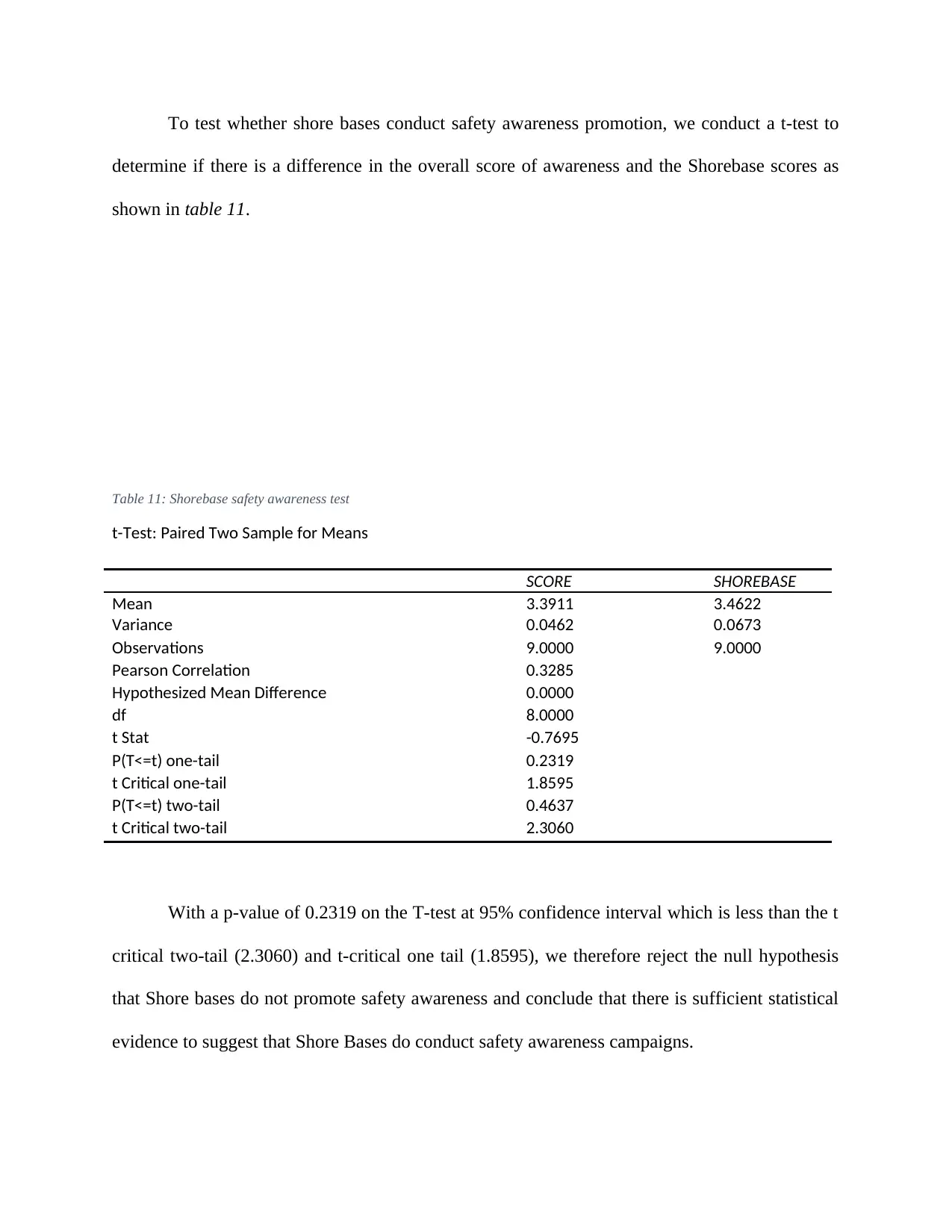
To test whether shore bases conduct safety awareness promotion, we conduct a t-test to
determine if there is a difference in the overall score of awareness and the Shorebase scores as
shown in table 11.
Table 11: Shorebase safety awareness test
t-Test: Paired Two Sample for Means
SCORE SHOREBASE
Mean 3.3911 3.4622
Variance 0.0462 0.0673
Observations 9.0000 9.0000
Pearson Correlation 0.3285
Hypothesized Mean Difference 0.0000
df 8.0000
t Stat -0.7695
P(T<=t) one-tail 0.2319
t Critical one-tail 1.8595
P(T<=t) two-tail 0.4637
t Critical two-tail 2.3060
With a p-value of 0.2319 on the T-test at 95% confidence interval which is less than the t
critical two-tail (2.3060) and t-critical one tail (1.8595), we therefore reject the null hypothesis
that Shore bases do not promote safety awareness and conclude that there is sufficient statistical
evidence to suggest that Shore Bases do conduct safety awareness campaigns.
determine if there is a difference in the overall score of awareness and the Shorebase scores as
shown in table 11.
Table 11: Shorebase safety awareness test
t-Test: Paired Two Sample for Means
SCORE SHOREBASE
Mean 3.3911 3.4622
Variance 0.0462 0.0673
Observations 9.0000 9.0000
Pearson Correlation 0.3285
Hypothesized Mean Difference 0.0000
df 8.0000
t Stat -0.7695
P(T<=t) one-tail 0.2319
t Critical one-tail 1.8595
P(T<=t) two-tail 0.4637
t Critical two-tail 2.3060
With a p-value of 0.2319 on the T-test at 95% confidence interval which is less than the t
critical two-tail (2.3060) and t-critical one tail (1.8595), we therefore reject the null hypothesis
that Shore bases do not promote safety awareness and conclude that there is sufficient statistical
evidence to suggest that Shore Bases do conduct safety awareness campaigns.
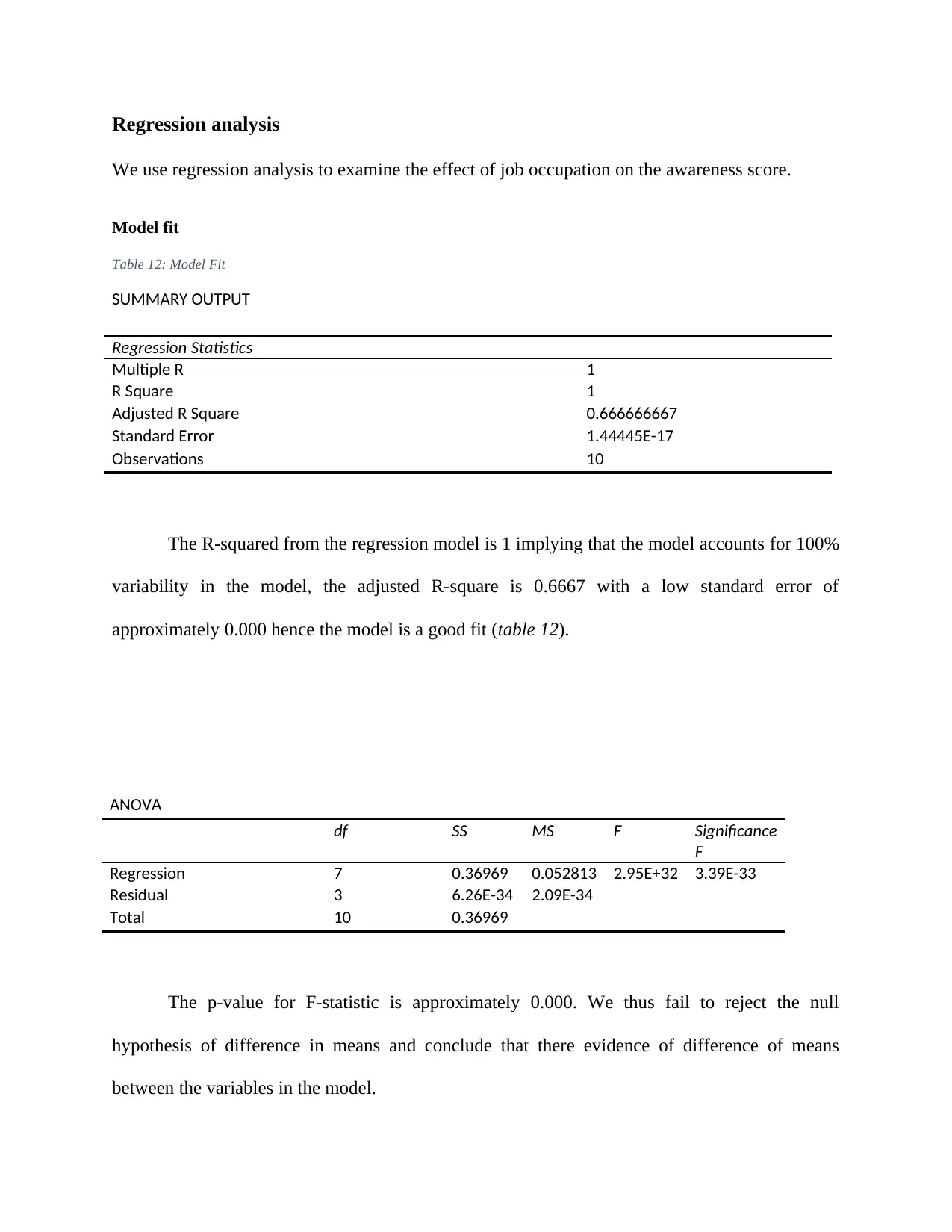
Regression analysis
We use regression analysis to examine the effect of job occupation on the awareness score.
Model fit
Table 12: Model Fit
SUMMARY OUTPUT
Regression Statistics
Multiple R 1
R Square 1
Adjusted R Square 0.666666667
Standard Error 1.44445E-17
Observations 10
The R-squared from the regression model is 1 implying that the model accounts for 100%
variability in the model, the adjusted R-square is 0.6667 with a low standard error of
approximately 0.000 hence the model is a good fit (table 12).
ANOVA
df SS MS F Significance
F
Regression 7 0.36969 0.052813 2.95E+32 3.39E-33
Residual 3 6.26E-34 2.09E-34
Total 10 0.36969
The p-value for F-statistic is approximately 0.000. We thus fail to reject the null
hypothesis of difference in means and conclude that there evidence of difference of means
between the variables in the model.
We use regression analysis to examine the effect of job occupation on the awareness score.
Model fit
Table 12: Model Fit
SUMMARY OUTPUT
Regression Statistics
Multiple R 1
R Square 1
Adjusted R Square 0.666666667
Standard Error 1.44445E-17
Observations 10
The R-squared from the regression model is 1 implying that the model accounts for 100%
variability in the model, the adjusted R-square is 0.6667 with a low standard error of
approximately 0.000 hence the model is a good fit (table 12).
ANOVA
df SS MS F Significance
F
Regression 7 0.36969 0.052813 2.95E+32 3.39E-33
Residual 3 6.26E-34 2.09E-34
Total 10 0.36969
The p-value for F-statistic is approximately 0.000. We thus fail to reject the null
hypothesis of difference in means and conclude that there evidence of difference of means
between the variables in the model.
Secure Best Marks with AI Grader
Need help grading? Try our AI Grader for instant feedback on your assignments.
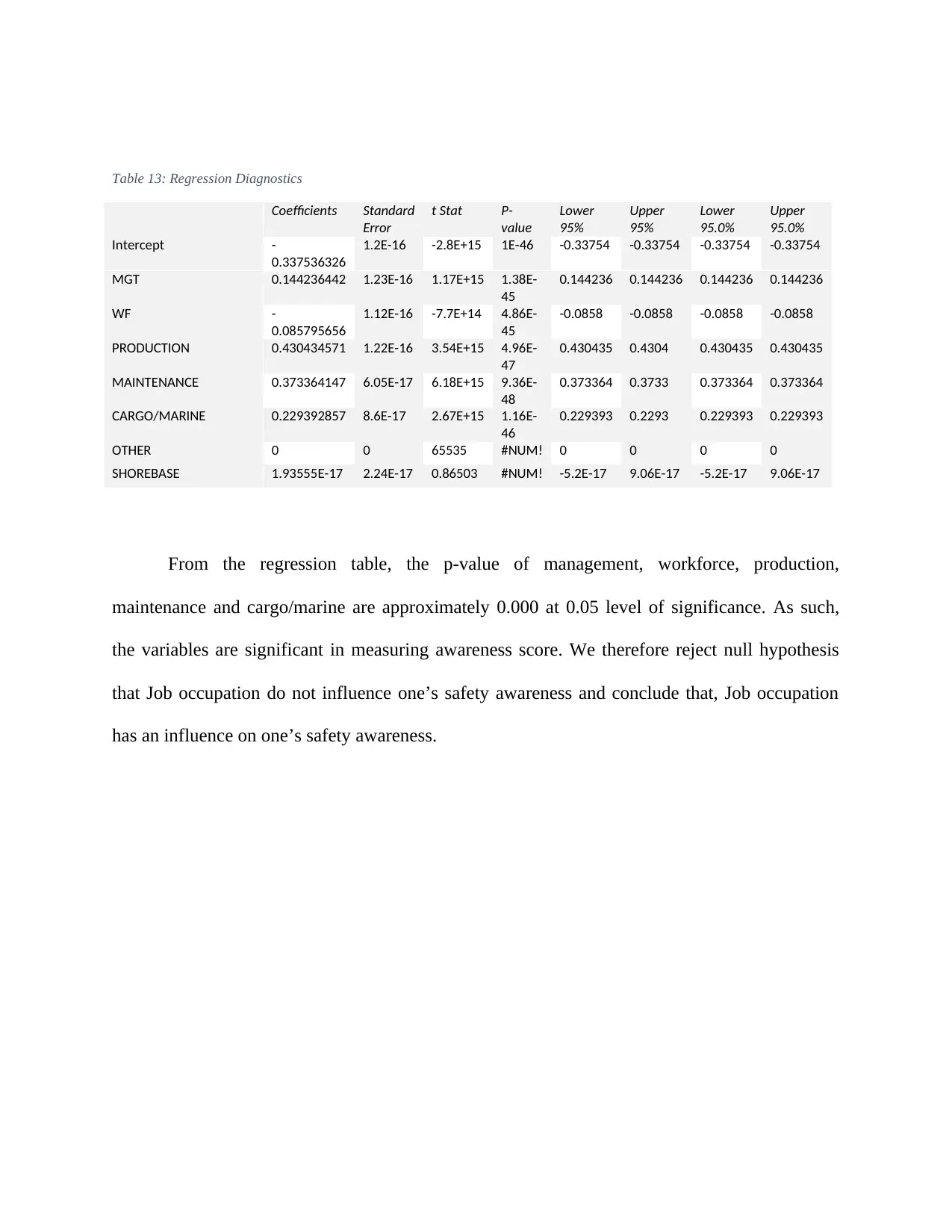
Table 13: Regression Diagnostics
Coefficients Standard
Error
t Stat P-
value
Lower
95%
Upper
95%
Lower
95.0%
Upper
95.0%
Intercept -
0.337536326
1.2E-16 -2.8E+15 1E-46 -0.33754 -0.33754 -0.33754 -0.33754
MGT 0.144236442 1.23E-16 1.17E+15 1.38E-
45
0.144236 0.144236 0.144236 0.144236
WF -
0.085795656
1.12E-16 -7.7E+14 4.86E-
45
-0.0858 -0.0858 -0.0858 -0.0858
PRODUCTION 0.430434571 1.22E-16 3.54E+15 4.96E-
47
0.430435 0.4304 0.430435 0.430435
MAINTENANCE 0.373364147 6.05E-17 6.18E+15 9.36E-
48
0.373364 0.3733 0.373364 0.373364
CARGO/MARINE 0.229392857 8.6E-17 2.67E+15 1.16E-
46
0.229393 0.2293 0.229393 0.229393
OTHER 0 0 65535 #NUM! 0 0 0 0
SHOREBASE 1.93555E-17 2.24E-17 0.86503 #NUM! -5.2E-17 9.06E-17 -5.2E-17 9.06E-17
From the regression table, the p-value of management, workforce, production,
maintenance and cargo/marine are approximately 0.000 at 0.05 level of significance. As such,
the variables are significant in measuring awareness score. We therefore reject null hypothesis
that Job occupation do not influence one’s safety awareness and conclude that, Job occupation
has an influence on one’s safety awareness.
Coefficients Standard
Error
t Stat P-
value
Lower
95%
Upper
95%
Lower
95.0%
Upper
95.0%
Intercept -
0.337536326
1.2E-16 -2.8E+15 1E-46 -0.33754 -0.33754 -0.33754 -0.33754
MGT 0.144236442 1.23E-16 1.17E+15 1.38E-
45
0.144236 0.144236 0.144236 0.144236
WF -
0.085795656
1.12E-16 -7.7E+14 4.86E-
45
-0.0858 -0.0858 -0.0858 -0.0858
PRODUCTION 0.430434571 1.22E-16 3.54E+15 4.96E-
47
0.430435 0.4304 0.430435 0.430435
MAINTENANCE 0.373364147 6.05E-17 6.18E+15 9.36E-
48
0.373364 0.3733 0.373364 0.373364
CARGO/MARINE 0.229392857 8.6E-17 2.67E+15 1.16E-
46
0.229393 0.2293 0.229393 0.229393
OTHER 0 0 65535 #NUM! 0 0 0 0
SHOREBASE 1.93555E-17 2.24E-17 0.86503 #NUM! -5.2E-17 9.06E-17 -5.2E-17 9.06E-17
From the regression table, the p-value of management, workforce, production,
maintenance and cargo/marine are approximately 0.000 at 0.05 level of significance. As such,
the variables are significant in measuring awareness score. We therefore reject null hypothesis
that Job occupation do not influence one’s safety awareness and conclude that, Job occupation
has an influence on one’s safety awareness.
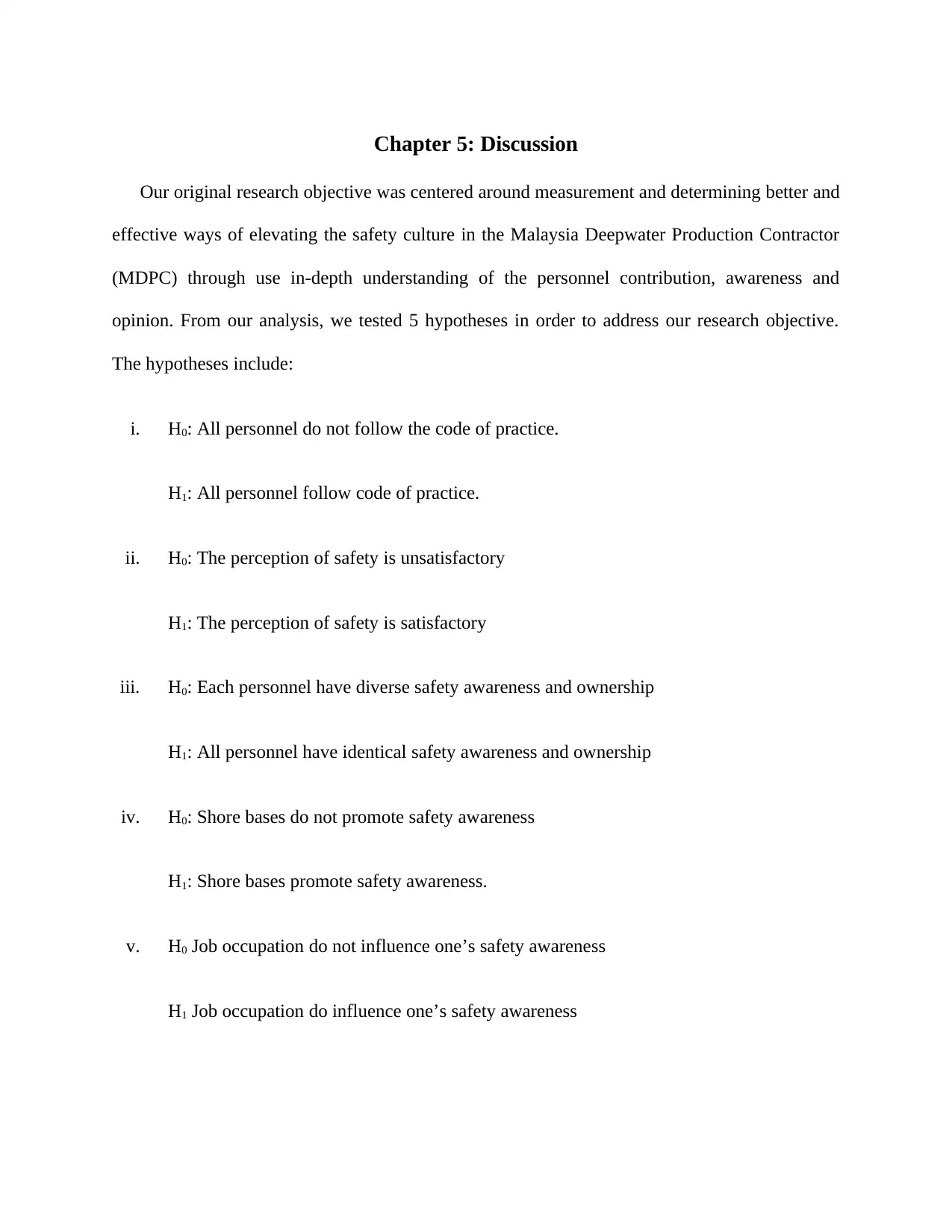
Chapter 5: Discussion
Our original research objective was centered around measurement and determining better and
effective ways of elevating the safety culture in the Malaysia Deepwater Production Contractor
(MDPC) through use in-depth understanding of the personnel contribution, awareness and
opinion. From our analysis, we tested 5 hypotheses in order to address our research objective.
The hypotheses include:
i. H0: All personnel do not follow the code of practice.
H1: All personnel follow code of practice.
ii. H0: The perception of safety is unsatisfactory
H1: The perception of safety is satisfactory
iii. H0: Each personnel have diverse safety awareness and ownership
H1: All personnel have identical safety awareness and ownership
iv. H0: Shore bases do not promote safety awareness
H1: Shore bases promote safety awareness.
v. H0 Job occupation do not influence one’s safety awareness
H1 Job occupation do influence one’s safety awareness
Our original research objective was centered around measurement and determining better and
effective ways of elevating the safety culture in the Malaysia Deepwater Production Contractor
(MDPC) through use in-depth understanding of the personnel contribution, awareness and
opinion. From our analysis, we tested 5 hypotheses in order to address our research objective.
The hypotheses include:
i. H0: All personnel do not follow the code of practice.
H1: All personnel follow code of practice.
ii. H0: The perception of safety is unsatisfactory
H1: The perception of safety is satisfactory
iii. H0: Each personnel have diverse safety awareness and ownership
H1: All personnel have identical safety awareness and ownership
iv. H0: Shore bases do not promote safety awareness
H1: Shore bases promote safety awareness.
v. H0 Job occupation do not influence one’s safety awareness
H1 Job occupation do influence one’s safety awareness
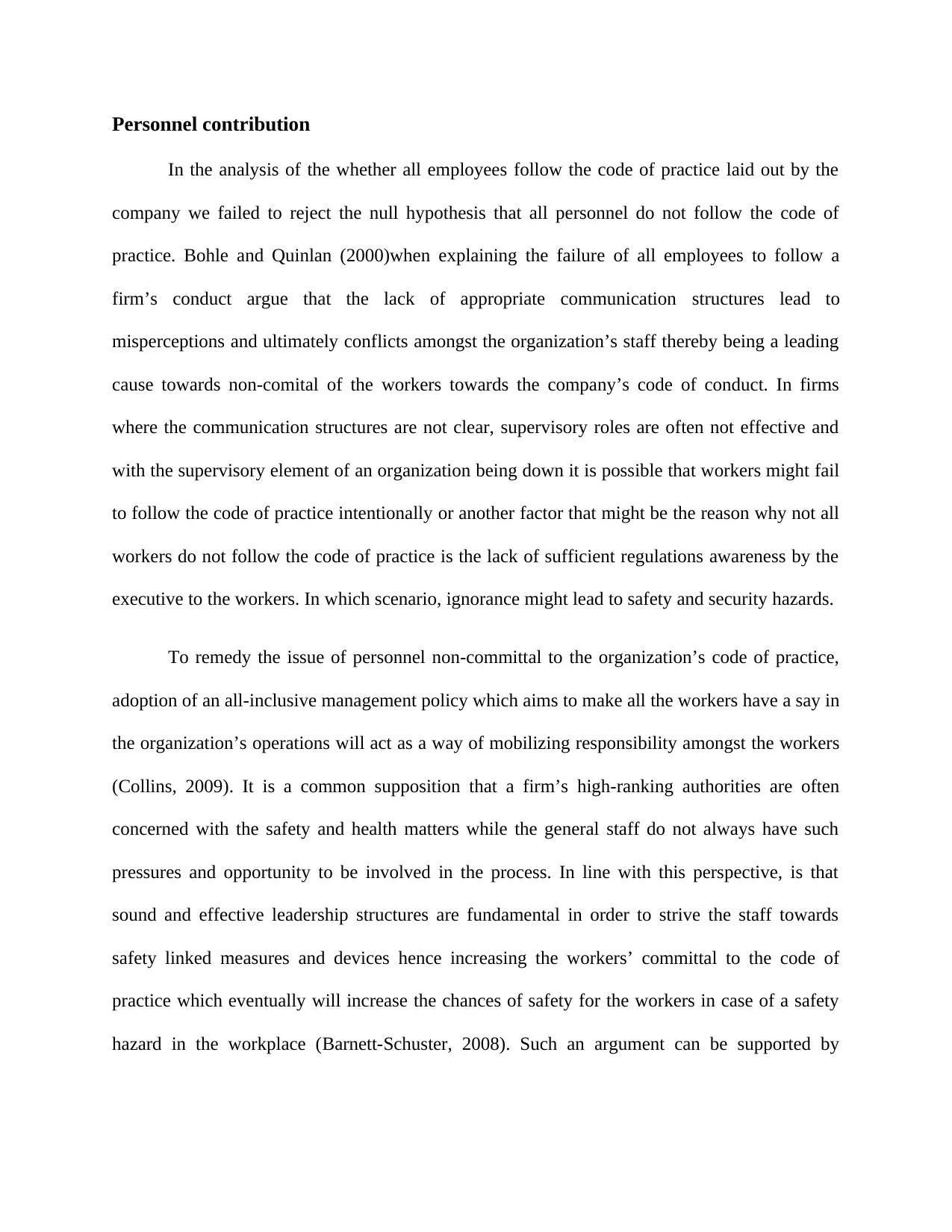
Personnel contribution
In the analysis of the whether all employees follow the code of practice laid out by the
company we failed to reject the null hypothesis that all personnel do not follow the code of
practice. Bohle and Quinlan (2000)when explaining the failure of all employees to follow a
firm’s conduct argue that the lack of appropriate communication structures lead to
misperceptions and ultimately conflicts amongst the organization’s staff thereby being a leading
cause towards non-comital of the workers towards the company’s code of conduct. In firms
where the communication structures are not clear, supervisory roles are often not effective and
with the supervisory element of an organization being down it is possible that workers might fail
to follow the code of practice intentionally or another factor that might be the reason why not all
workers do not follow the code of practice is the lack of sufficient regulations awareness by the
executive to the workers. In which scenario, ignorance might lead to safety and security hazards.
To remedy the issue of personnel non-committal to the organization’s code of practice,
adoption of an all-inclusive management policy which aims to make all the workers have a say in
the organization’s operations will act as a way of mobilizing responsibility amongst the workers
(Collins, 2009). It is a common supposition that a firm’s high-ranking authorities are often
concerned with the safety and health matters while the general staff do not always have such
pressures and opportunity to be involved in the process. In line with this perspective, is that
sound and effective leadership structures are fundamental in order to strive the staff towards
safety linked measures and devices hence increasing the workers’ committal to the code of
practice which eventually will increase the chances of safety for the workers in case of a safety
hazard in the workplace (Barnett-Schuster, 2008). Such an argument can be supported by
In the analysis of the whether all employees follow the code of practice laid out by the
company we failed to reject the null hypothesis that all personnel do not follow the code of
practice. Bohle and Quinlan (2000)when explaining the failure of all employees to follow a
firm’s conduct argue that the lack of appropriate communication structures lead to
misperceptions and ultimately conflicts amongst the organization’s staff thereby being a leading
cause towards non-comital of the workers towards the company’s code of conduct. In firms
where the communication structures are not clear, supervisory roles are often not effective and
with the supervisory element of an organization being down it is possible that workers might fail
to follow the code of practice intentionally or another factor that might be the reason why not all
workers do not follow the code of practice is the lack of sufficient regulations awareness by the
executive to the workers. In which scenario, ignorance might lead to safety and security hazards.
To remedy the issue of personnel non-committal to the organization’s code of practice,
adoption of an all-inclusive management policy which aims to make all the workers have a say in
the organization’s operations will act as a way of mobilizing responsibility amongst the workers
(Collins, 2009). It is a common supposition that a firm’s high-ranking authorities are often
concerned with the safety and health matters while the general staff do not always have such
pressures and opportunity to be involved in the process. In line with this perspective, is that
sound and effective leadership structures are fundamental in order to strive the staff towards
safety linked measures and devices hence increasing the workers’ committal to the code of
practice which eventually will increase the chances of safety for the workers in case of a safety
hazard in the workplace (Barnett-Schuster, 2008). Such an argument can be supported by
Paraphrase This Document
Need a fresh take? Get an instant paraphrase of this document with our AI Paraphraser
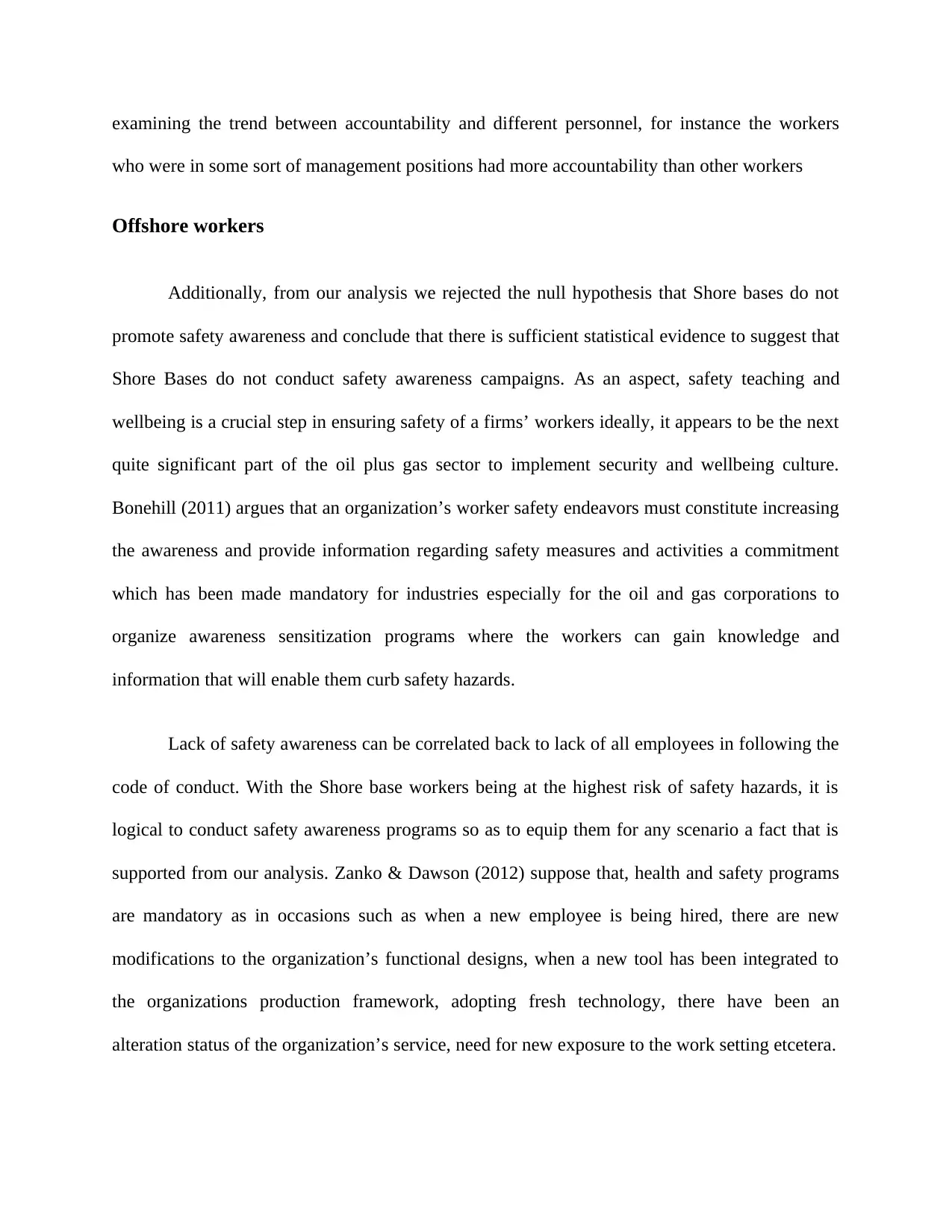
examining the trend between accountability and different personnel, for instance the workers
who were in some sort of management positions had more accountability than other workers
Offshore workers
Additionally, from our analysis we rejected the null hypothesis that Shore bases do not
promote safety awareness and conclude that there is sufficient statistical evidence to suggest that
Shore Bases do not conduct safety awareness campaigns. As an aspect, safety teaching and
wellbeing is a crucial step in ensuring safety of a firms’ workers ideally, it appears to be the next
quite significant part of the oil plus gas sector to implement security and wellbeing culture.
Bonehill (2011) argues that an organization’s worker safety endeavors must constitute increasing
the awareness and provide information regarding safety measures and activities a commitment
which has been made mandatory for industries especially for the oil and gas corporations to
organize awareness sensitization programs where the workers can gain knowledge and
information that will enable them curb safety hazards.
Lack of safety awareness can be correlated back to lack of all employees in following the
code of conduct. With the Shore base workers being at the highest risk of safety hazards, it is
logical to conduct safety awareness programs so as to equip them for any scenario a fact that is
supported from our analysis. Zanko & Dawson (2012) suppose that, health and safety programs
are mandatory as in occasions such as when a new employee is being hired, there are new
modifications to the organization’s functional designs, when a new tool has been integrated to
the organizations production framework, adopting fresh technology, there have been an
alteration status of the organization’s service, need for new exposure to the work setting etcetera.
who were in some sort of management positions had more accountability than other workers
Offshore workers
Additionally, from our analysis we rejected the null hypothesis that Shore bases do not
promote safety awareness and conclude that there is sufficient statistical evidence to suggest that
Shore Bases do not conduct safety awareness campaigns. As an aspect, safety teaching and
wellbeing is a crucial step in ensuring safety of a firms’ workers ideally, it appears to be the next
quite significant part of the oil plus gas sector to implement security and wellbeing culture.
Bonehill (2011) argues that an organization’s worker safety endeavors must constitute increasing
the awareness and provide information regarding safety measures and activities a commitment
which has been made mandatory for industries especially for the oil and gas corporations to
organize awareness sensitization programs where the workers can gain knowledge and
information that will enable them curb safety hazards.
Lack of safety awareness can be correlated back to lack of all employees in following the
code of conduct. With the Shore base workers being at the highest risk of safety hazards, it is
logical to conduct safety awareness programs so as to equip them for any scenario a fact that is
supported from our analysis. Zanko & Dawson (2012) suppose that, health and safety programs
are mandatory as in occasions such as when a new employee is being hired, there are new
modifications to the organization’s functional designs, when a new tool has been integrated to
the organizations production framework, adopting fresh technology, there have been an
alteration status of the organization’s service, need for new exposure to the work setting etcetera.
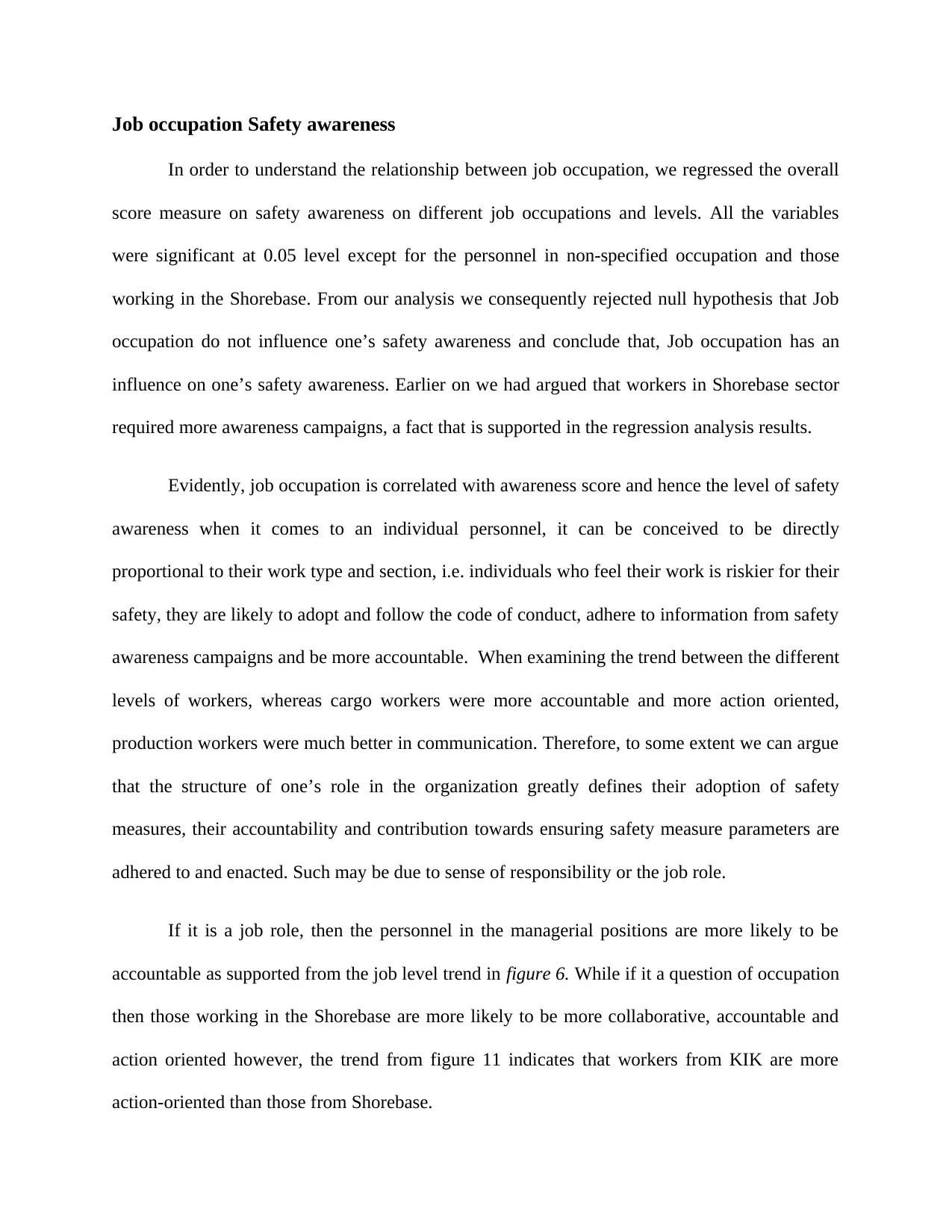
Job occupation Safety awareness
In order to understand the relationship between job occupation, we regressed the overall
score measure on safety awareness on different job occupations and levels. All the variables
were significant at 0.05 level except for the personnel in non-specified occupation and those
working in the Shorebase. From our analysis we consequently rejected null hypothesis that Job
occupation do not influence one’s safety awareness and conclude that, Job occupation has an
influence on one’s safety awareness. Earlier on we had argued that workers in Shorebase sector
required more awareness campaigns, a fact that is supported in the regression analysis results.
Evidently, job occupation is correlated with awareness score and hence the level of safety
awareness when it comes to an individual personnel, it can be conceived to be directly
proportional to their work type and section, i.e. individuals who feel their work is riskier for their
safety, they are likely to adopt and follow the code of conduct, adhere to information from safety
awareness campaigns and be more accountable. When examining the trend between the different
levels of workers, whereas cargo workers were more accountable and more action oriented,
production workers were much better in communication. Therefore, to some extent we can argue
that the structure of one’s role in the organization greatly defines their adoption of safety
measures, their accountability and contribution towards ensuring safety measure parameters are
adhered to and enacted. Such may be due to sense of responsibility or the job role.
If it is a job role, then the personnel in the managerial positions are more likely to be
accountable as supported from the job level trend in figure 6. While if it a question of occupation
then those working in the Shorebase are more likely to be more collaborative, accountable and
action oriented however, the trend from figure 11 indicates that workers from KIK are more
action-oriented than those from Shorebase.
In order to understand the relationship between job occupation, we regressed the overall
score measure on safety awareness on different job occupations and levels. All the variables
were significant at 0.05 level except for the personnel in non-specified occupation and those
working in the Shorebase. From our analysis we consequently rejected null hypothesis that Job
occupation do not influence one’s safety awareness and conclude that, Job occupation has an
influence on one’s safety awareness. Earlier on we had argued that workers in Shorebase sector
required more awareness campaigns, a fact that is supported in the regression analysis results.
Evidently, job occupation is correlated with awareness score and hence the level of safety
awareness when it comes to an individual personnel, it can be conceived to be directly
proportional to their work type and section, i.e. individuals who feel their work is riskier for their
safety, they are likely to adopt and follow the code of conduct, adhere to information from safety
awareness campaigns and be more accountable. When examining the trend between the different
levels of workers, whereas cargo workers were more accountable and more action oriented,
production workers were much better in communication. Therefore, to some extent we can argue
that the structure of one’s role in the organization greatly defines their adoption of safety
measures, their accountability and contribution towards ensuring safety measure parameters are
adhered to and enacted. Such may be due to sense of responsibility or the job role.
If it is a job role, then the personnel in the managerial positions are more likely to be
accountable as supported from the job level trend in figure 6. While if it a question of occupation
then those working in the Shorebase are more likely to be more collaborative, accountable and
action oriented however, the trend from figure 11 indicates that workers from KIK are more
action-oriented than those from Shorebase.
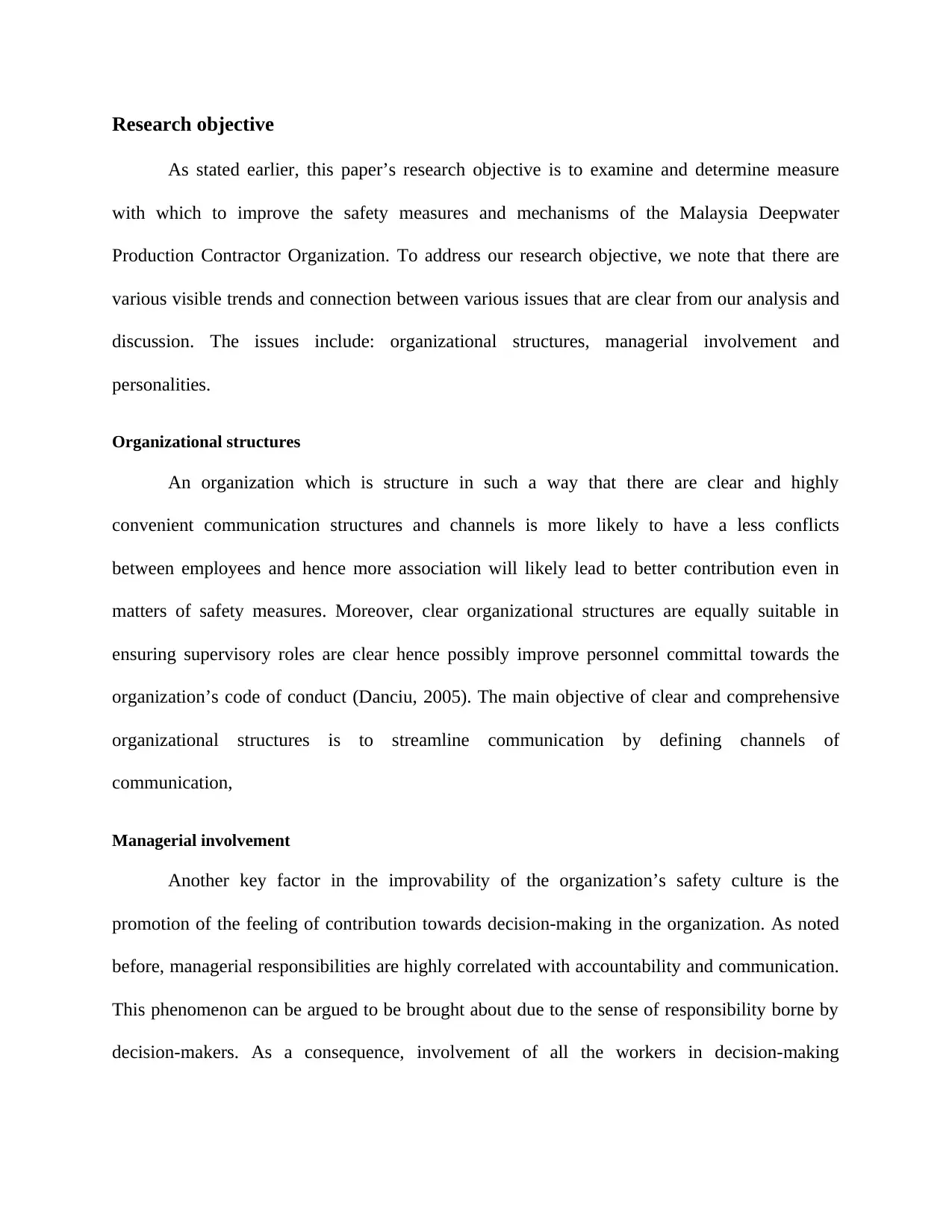
Research objective
As stated earlier, this paper’s research objective is to examine and determine measure
with which to improve the safety measures and mechanisms of the Malaysia Deepwater
Production Contractor Organization. To address our research objective, we note that there are
various visible trends and connection between various issues that are clear from our analysis and
discussion. The issues include: organizational structures, managerial involvement and
personalities.
Organizational structures
An organization which is structure in such a way that there are clear and highly
convenient communication structures and channels is more likely to have a less conflicts
between employees and hence more association will likely lead to better contribution even in
matters of safety measures. Moreover, clear organizational structures are equally suitable in
ensuring supervisory roles are clear hence possibly improve personnel committal towards the
organization’s code of conduct (Danciu, 2005). The main objective of clear and comprehensive
organizational structures is to streamline communication by defining channels of
communication,
Managerial involvement
Another key factor in the improvability of the organization’s safety culture is the
promotion of the feeling of contribution towards decision-making in the organization. As noted
before, managerial responsibilities are highly correlated with accountability and communication.
This phenomenon can be argued to be brought about due to the sense of responsibility borne by
decision-makers. As a consequence, involvement of all the workers in decision-making
As stated earlier, this paper’s research objective is to examine and determine measure
with which to improve the safety measures and mechanisms of the Malaysia Deepwater
Production Contractor Organization. To address our research objective, we note that there are
various visible trends and connection between various issues that are clear from our analysis and
discussion. The issues include: organizational structures, managerial involvement and
personalities.
Organizational structures
An organization which is structure in such a way that there are clear and highly
convenient communication structures and channels is more likely to have a less conflicts
between employees and hence more association will likely lead to better contribution even in
matters of safety measures. Moreover, clear organizational structures are equally suitable in
ensuring supervisory roles are clear hence possibly improve personnel committal towards the
organization’s code of conduct (Danciu, 2005). The main objective of clear and comprehensive
organizational structures is to streamline communication by defining channels of
communication,
Managerial involvement
Another key factor in the improvability of the organization’s safety culture is the
promotion of the feeling of contribution towards decision-making in the organization. As noted
before, managerial responsibilities are highly correlated with accountability and communication.
This phenomenon can be argued to be brought about due to the sense of responsibility borne by
decision-makers. As a consequence, involvement of all the workers in decision-making
Secure Best Marks with AI Grader
Need help grading? Try our AI Grader for instant feedback on your assignments.
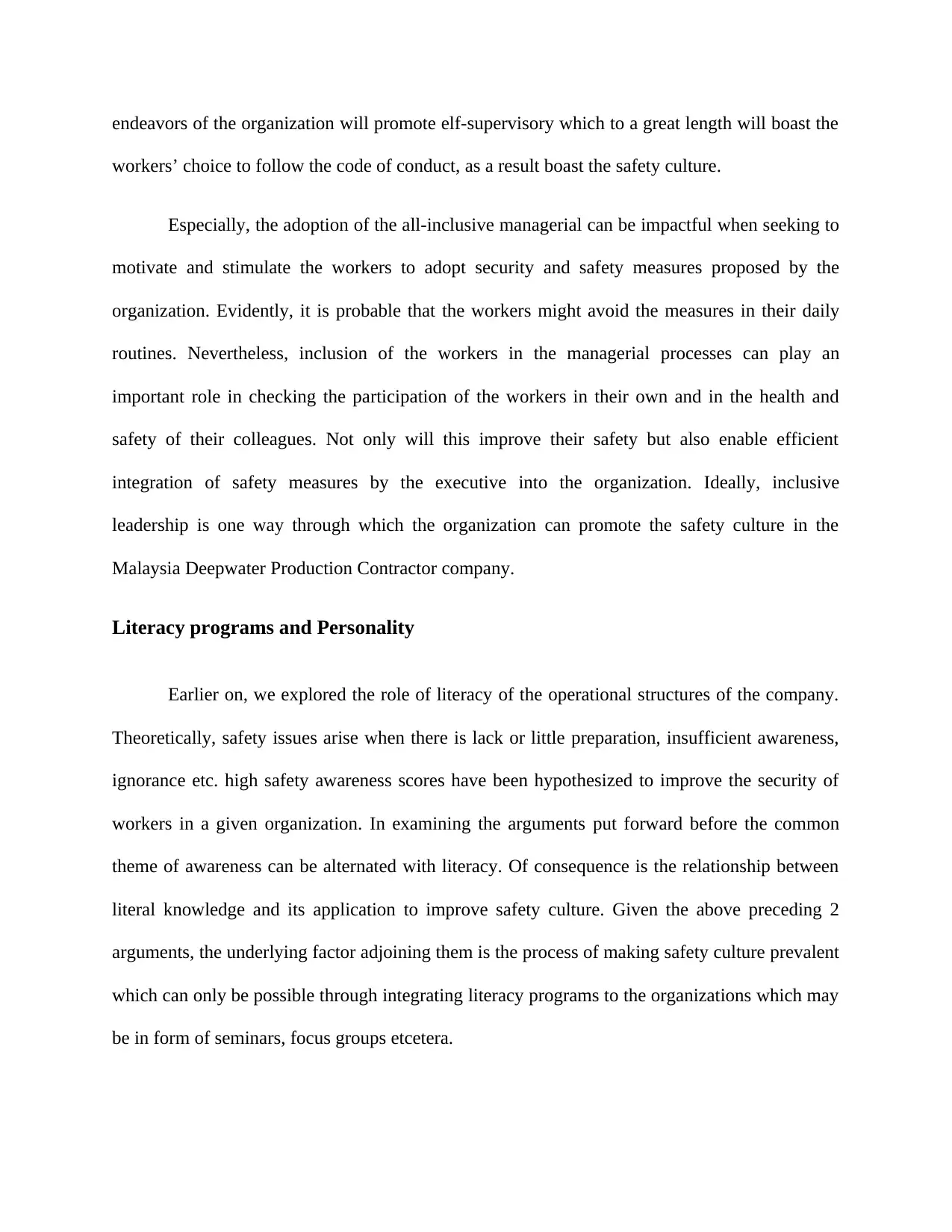
endeavors of the organization will promote elf-supervisory which to a great length will boast the
workers’ choice to follow the code of conduct, as a result boast the safety culture.
Especially, the adoption of the all-inclusive managerial can be impactful when seeking to
motivate and stimulate the workers to adopt security and safety measures proposed by the
organization. Evidently, it is probable that the workers might avoid the measures in their daily
routines. Nevertheless, inclusion of the workers in the managerial processes can play an
important role in checking the participation of the workers in their own and in the health and
safety of their colleagues. Not only will this improve their safety but also enable efficient
integration of safety measures by the executive into the organization. Ideally, inclusive
leadership is one way through which the organization can promote the safety culture in the
Malaysia Deepwater Production Contractor company.
Literacy programs and Personality
Earlier on, we explored the role of literacy of the operational structures of the company.
Theoretically, safety issues arise when there is lack or little preparation, insufficient awareness,
ignorance etc. high safety awareness scores have been hypothesized to improve the security of
workers in a given organization. In examining the arguments put forward before the common
theme of awareness can be alternated with literacy. Of consequence is the relationship between
literal knowledge and its application to improve safety culture. Given the above preceding 2
arguments, the underlying factor adjoining them is the process of making safety culture prevalent
which can only be possible through integrating literacy programs to the organizations which may
be in form of seminars, focus groups etcetera.
workers’ choice to follow the code of conduct, as a result boast the safety culture.
Especially, the adoption of the all-inclusive managerial can be impactful when seeking to
motivate and stimulate the workers to adopt security and safety measures proposed by the
organization. Evidently, it is probable that the workers might avoid the measures in their daily
routines. Nevertheless, inclusion of the workers in the managerial processes can play an
important role in checking the participation of the workers in their own and in the health and
safety of their colleagues. Not only will this improve their safety but also enable efficient
integration of safety measures by the executive into the organization. Ideally, inclusive
leadership is one way through which the organization can promote the safety culture in the
Malaysia Deepwater Production Contractor company.
Literacy programs and Personality
Earlier on, we explored the role of literacy of the operational structures of the company.
Theoretically, safety issues arise when there is lack or little preparation, insufficient awareness,
ignorance etc. high safety awareness scores have been hypothesized to improve the security of
workers in a given organization. In examining the arguments put forward before the common
theme of awareness can be alternated with literacy. Of consequence is the relationship between
literal knowledge and its application to improve safety culture. Given the above preceding 2
arguments, the underlying factor adjoining them is the process of making safety culture prevalent
which can only be possible through integrating literacy programs to the organizations which may
be in form of seminars, focus groups etcetera.
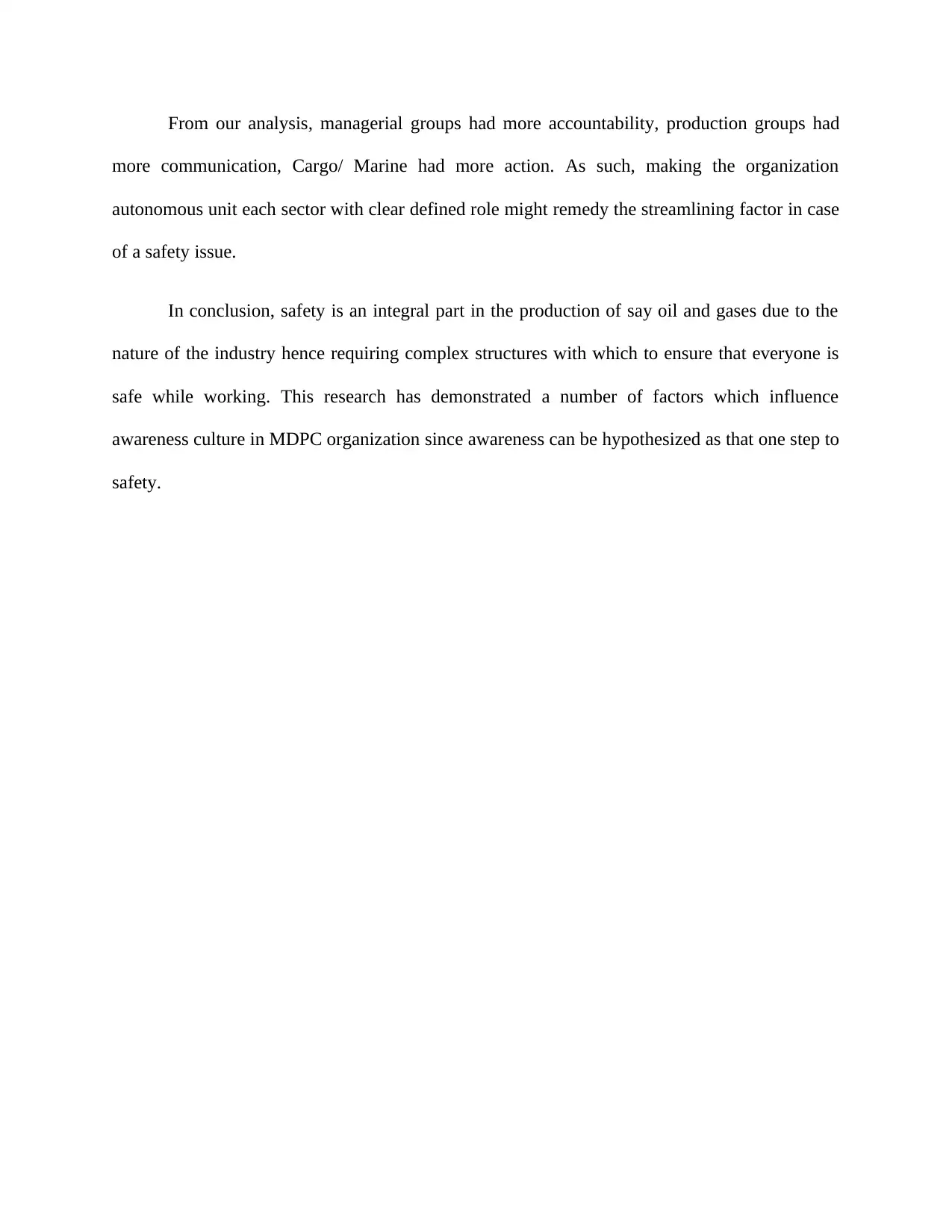
From our analysis, managerial groups had more accountability, production groups had
more communication, Cargo/ Marine had more action. As such, making the organization
autonomous unit each sector with clear defined role might remedy the streamlining factor in case
of a safety issue.
In conclusion, safety is an integral part in the production of say oil and gases due to the
nature of the industry hence requiring complex structures with which to ensure that everyone is
safe while working. This research has demonstrated a number of factors which influence
awareness culture in MDPC organization since awareness can be hypothesized as that one step to
safety.
more communication, Cargo/ Marine had more action. As such, making the organization
autonomous unit each sector with clear defined role might remedy the streamlining factor in case
of a safety issue.
In conclusion, safety is an integral part in the production of say oil and gases due to the
nature of the industry hence requiring complex structures with which to ensure that everyone is
safe while working. This research has demonstrated a number of factors which influence
awareness culture in MDPC organization since awareness can be hypothesized as that one step to
safety.
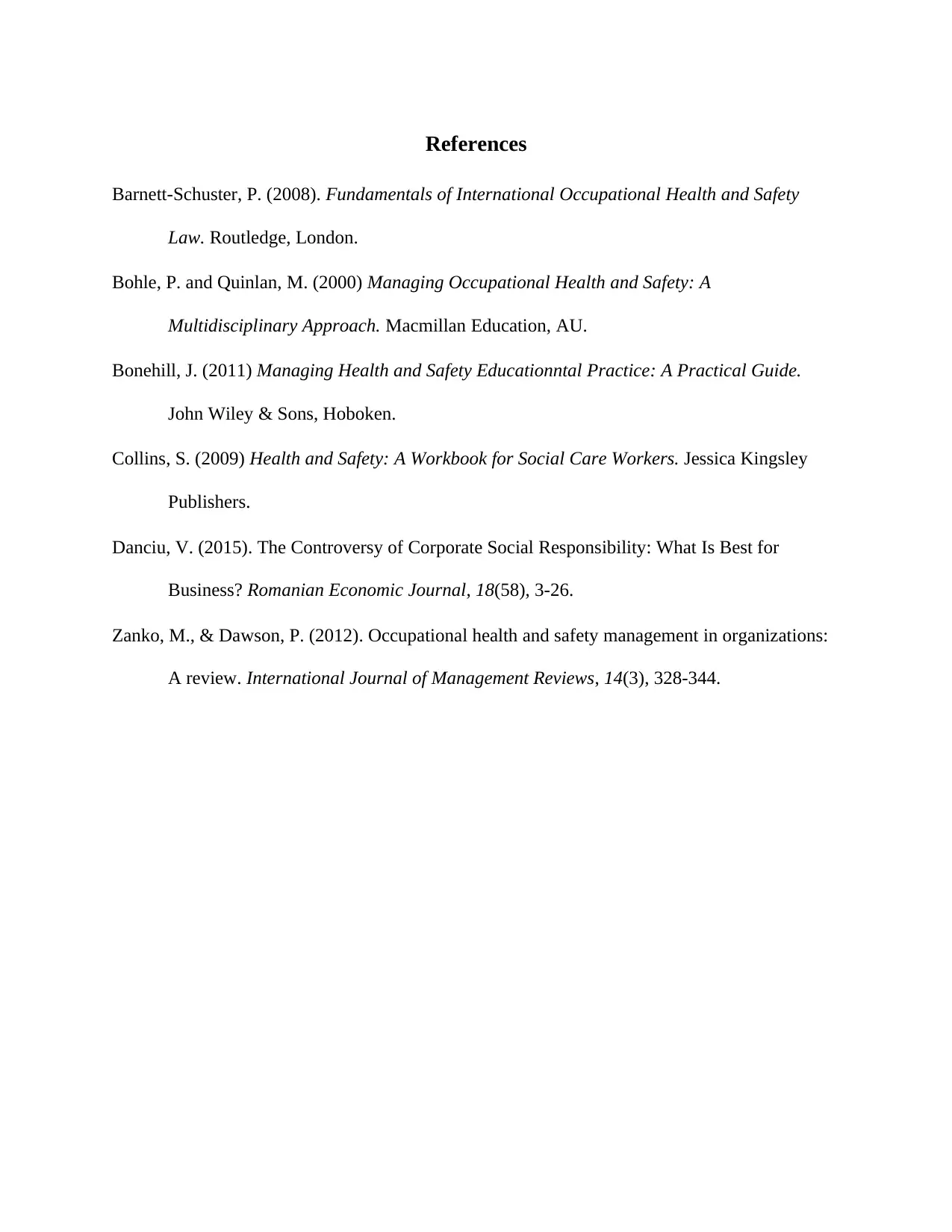
References
Barnett-Schuster, P. (2008). Fundamentals of International Occupational Health and Safety
Law. Routledge, London.
Bohle, P. and Quinlan, M. (2000) Managing Occupational Health and Safety: A
Multidisciplinary Approach. Macmillan Education, AU.
Bonehill, J. (2011) Managing Health and Safety Educationntal Practice: A Practical Guide.
John Wiley & Sons, Hoboken.
Collins, S. (2009) Health and Safety: A Workbook for Social Care Workers. Jessica Kingsley
Publishers.
Danciu, V. (2015). The Controversy of Corporate Social Responsibility: What Is Best for
Business? Romanian Economic Journal, 18(58), 3-26.
Zanko, M., & Dawson, P. (2012). Occupational health and safety management in organizations:
A review. International Journal of Management Reviews, 14(3), 328-344.
Barnett-Schuster, P. (2008). Fundamentals of International Occupational Health and Safety
Law. Routledge, London.
Bohle, P. and Quinlan, M. (2000) Managing Occupational Health and Safety: A
Multidisciplinary Approach. Macmillan Education, AU.
Bonehill, J. (2011) Managing Health and Safety Educationntal Practice: A Practical Guide.
John Wiley & Sons, Hoboken.
Collins, S. (2009) Health and Safety: A Workbook for Social Care Workers. Jessica Kingsley
Publishers.
Danciu, V. (2015). The Controversy of Corporate Social Responsibility: What Is Best for
Business? Romanian Economic Journal, 18(58), 3-26.
Zanko, M., & Dawson, P. (2012). Occupational health and safety management in organizations:
A review. International Journal of Management Reviews, 14(3), 328-344.
1 out of 25
Your All-in-One AI-Powered Toolkit for Academic Success.
+13062052269
info@desklib.com
Available 24*7 on WhatsApp / Email
![[object Object]](/_next/static/media/star-bottom.7253800d.svg)
Unlock your academic potential
© 2024 | Zucol Services PVT LTD | All rights reserved.